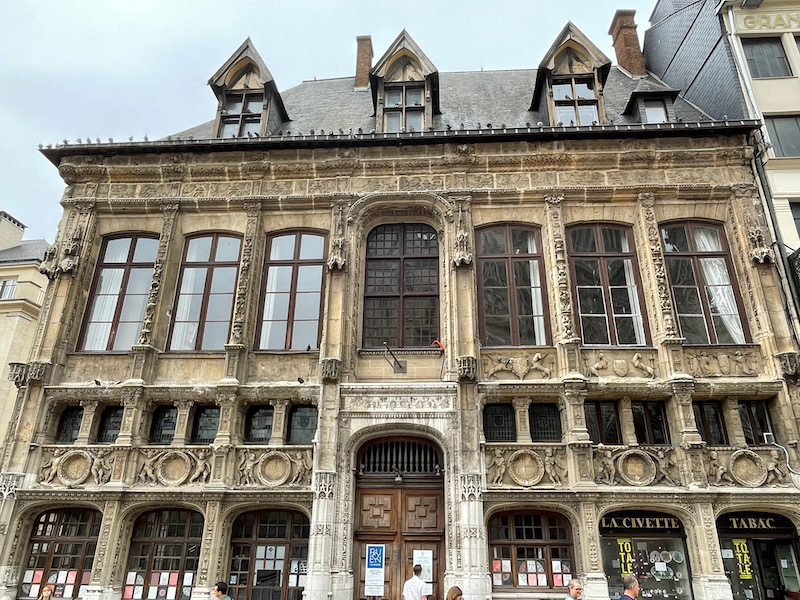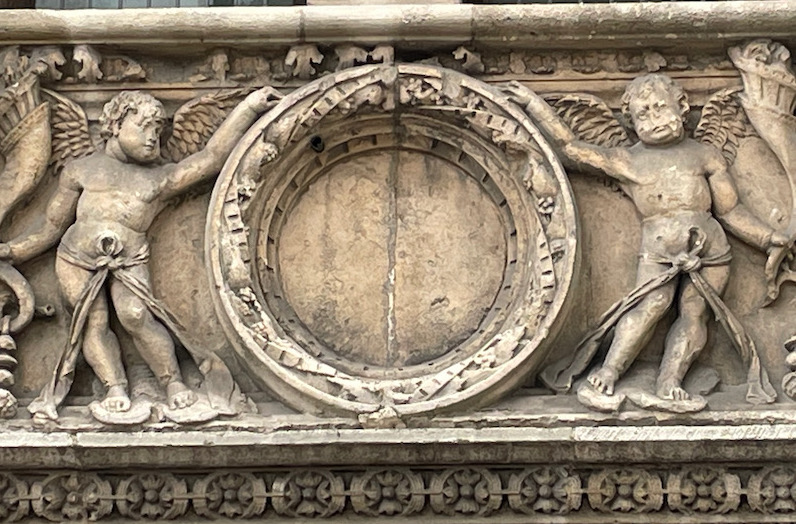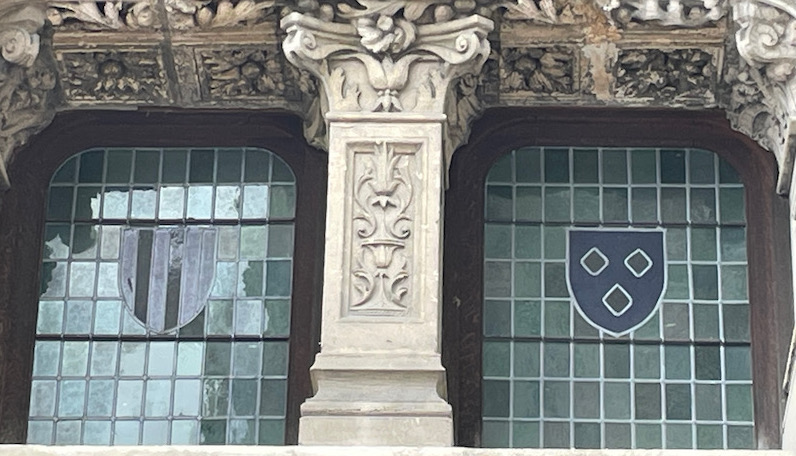Our Blog - Summer 2024 Trip - Rouen, France
We visited Rouen back in 2007 and if you were reading my blog back then, you will see a few familiar pictures but with the digital camera now, I have a much better selection of pictures :-) I also tried not to go through the same exact pictures that I did before.
Rouen is mainly known as the place where Joan of Arc was burned at the stake. But it actually has a much larger history than just that. It goes back to the 5th century when the Archdiocese of Rouen was created. Starting around 841, the Normans took over Rouen and from 912, Rouen was the capital of the Duchy of Normandy and residence of the local dukes until William the Conqueror moved his residence to Caen. In 1204, King Philip II Augustus of France entered Rouen and annexed Normandy to the French Kingdom. In 1419, Rouen surrendered after a long siege to Henry V of England during the Hundred Years' War, and back it went to England, under the Plantagenet domains. Soon after, in 1431, Joan of Arc was burned at the stake for her support of French rule.
We started at the Hotel de Ville and Square Charles de Gaulle, where there is a monument to Napoleon I, featuring a bronze equestrian statue of Napoleon on horseback. He is depicted in military attire, a characteristic hat, and a pose that exudes authority and leadership. The statue captures the essence of Napoleon as a military commander.
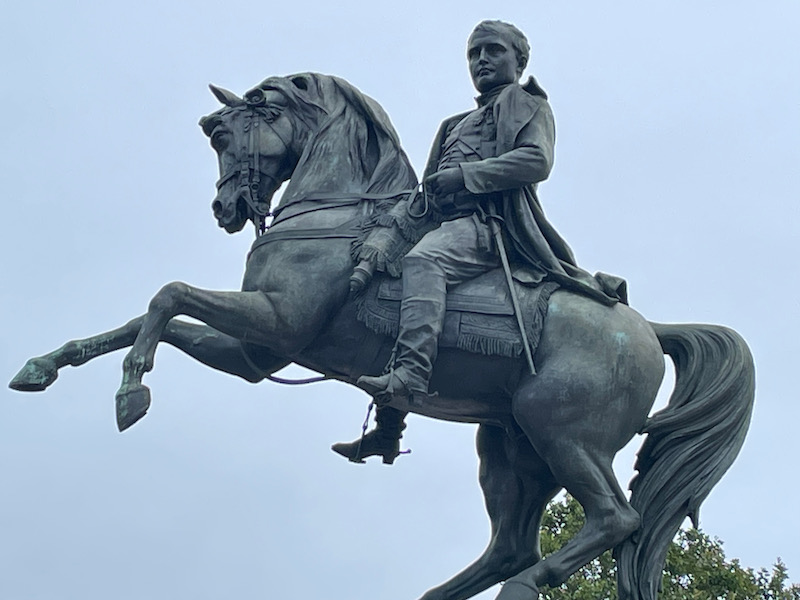
Just next door is the Abbey church of the Saint-Ouen Abbey. There is work going on, some things were blocked off. The first pictures is the back of the church, taken from a small park. I didn't actually get any pictures of the front of the church as it was covered. The Abbey of Saint-Ouen was one of the most powerful Benedictine monasteries in Normandy, founded in 750 under the patronage of Saint Peter. Multiple churches have been built and destroyed, this one being started in 1318. The nave was finally completed in 1537 with the Western façade not being completed until the 19th century.
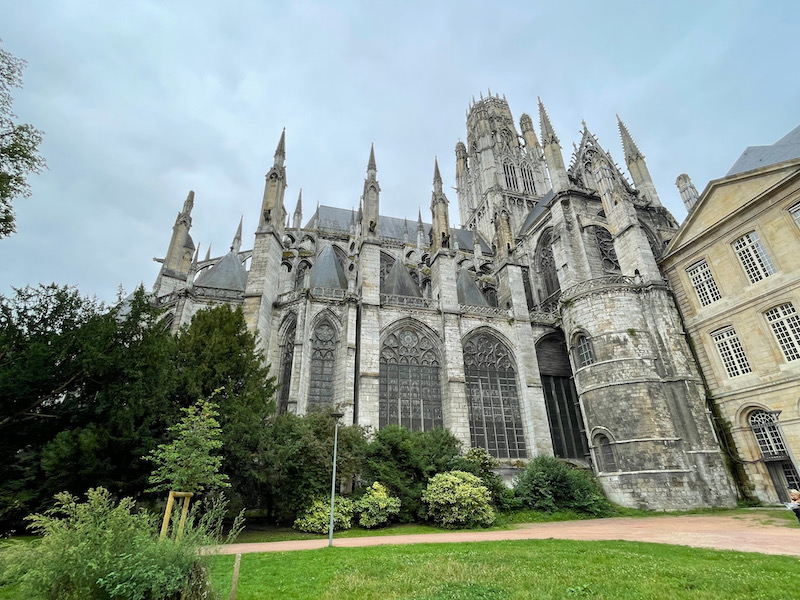
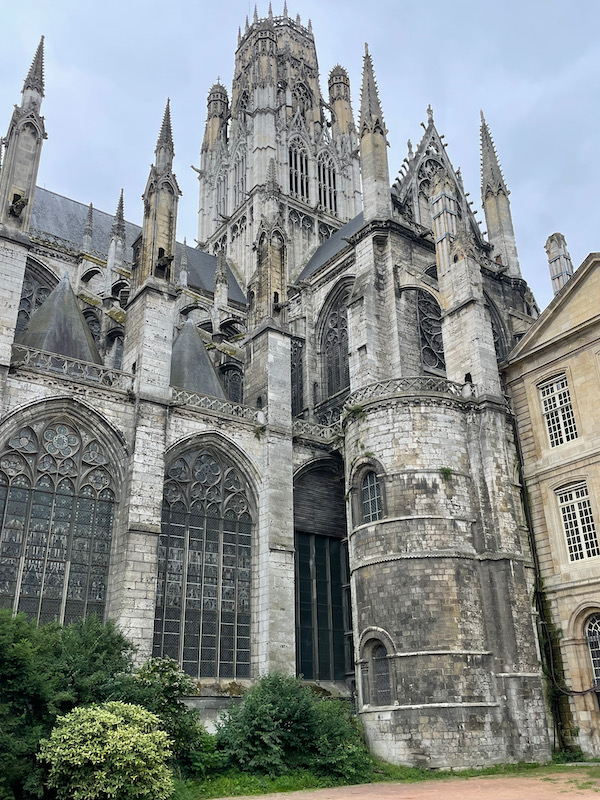
Then around to the Portail des Marmousets, which seemed to have been recently cleaned. The statue in the middle is that of Saint Ouen, who was the bishop of Rouen in the 7th century.
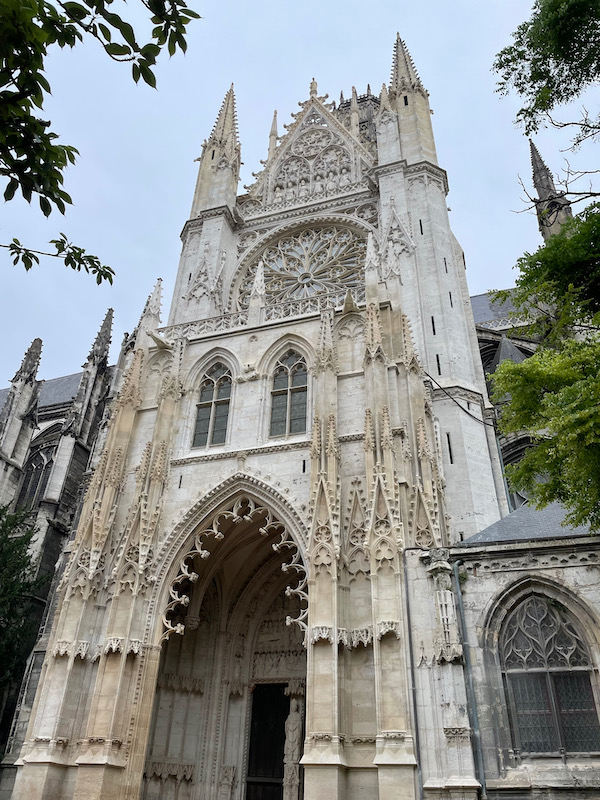
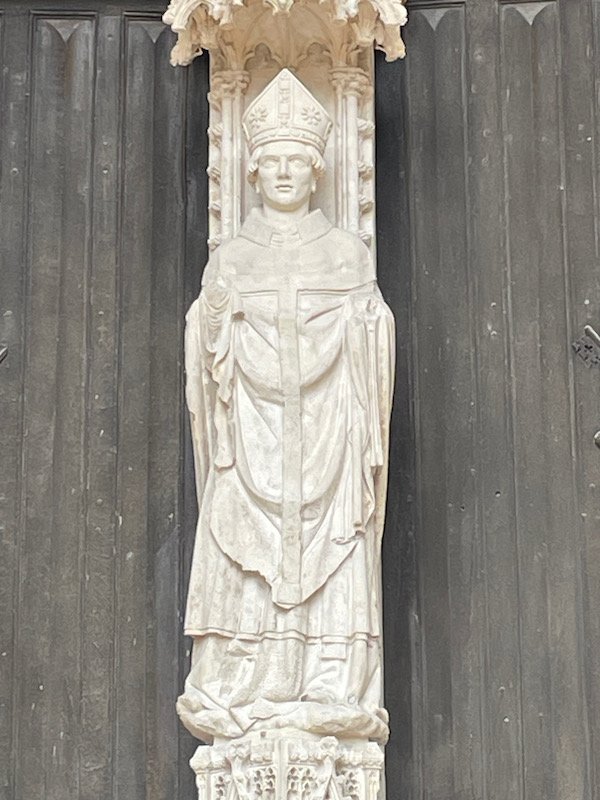
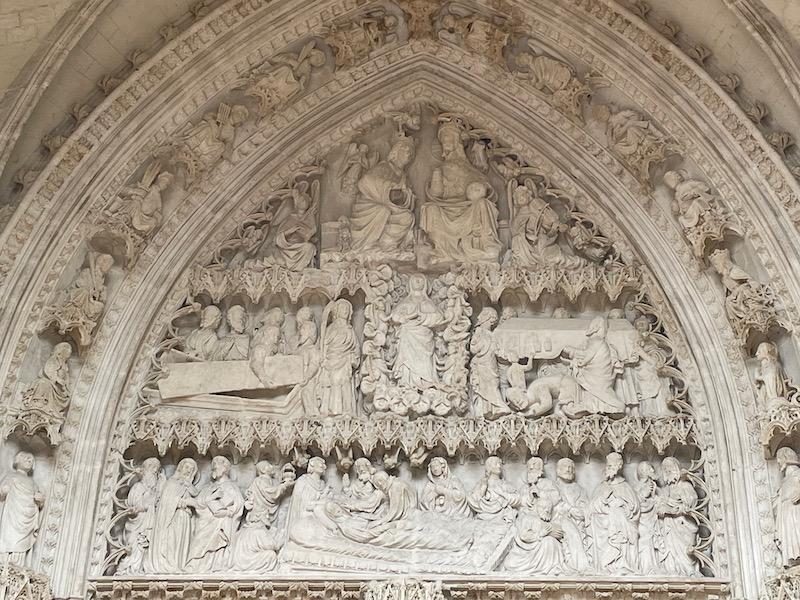
The church is built in a Gothic style, with very tall pointed arches. The nave, very bright thanks to its glass windows on three levels and the size of its bays, is typical of the flamboyant Gothic style. Due to the ongoing work, there wasn't much in the way of furnishings inside.
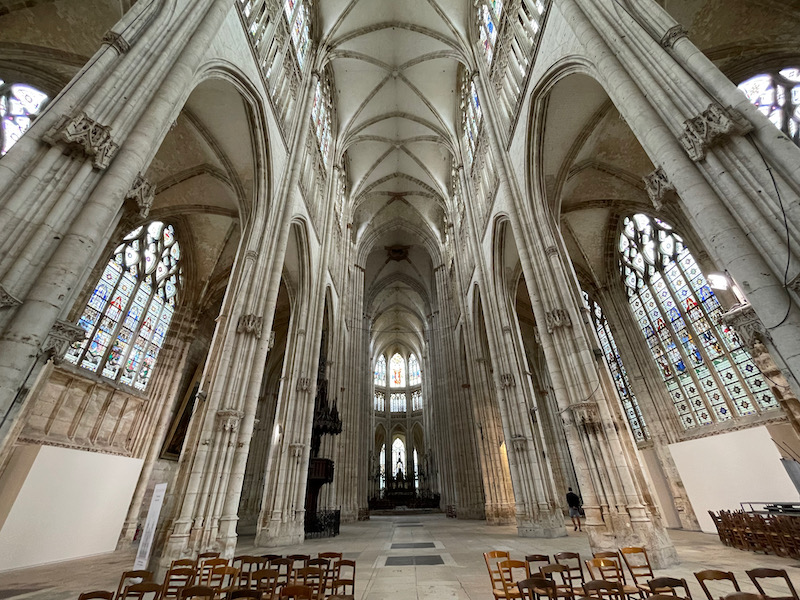
Even though there isn't much furniture, there are still quite a few stained-glass windows. There are over 80 windows that were made mainly between the 14th and 15th centuries with a few from the 19th century. What I found interesting about this first set (with detail in picture #2) is that it has a biblical scene but the stained glass above almost seems to have it framed with Flamboyant Gothic tracery.
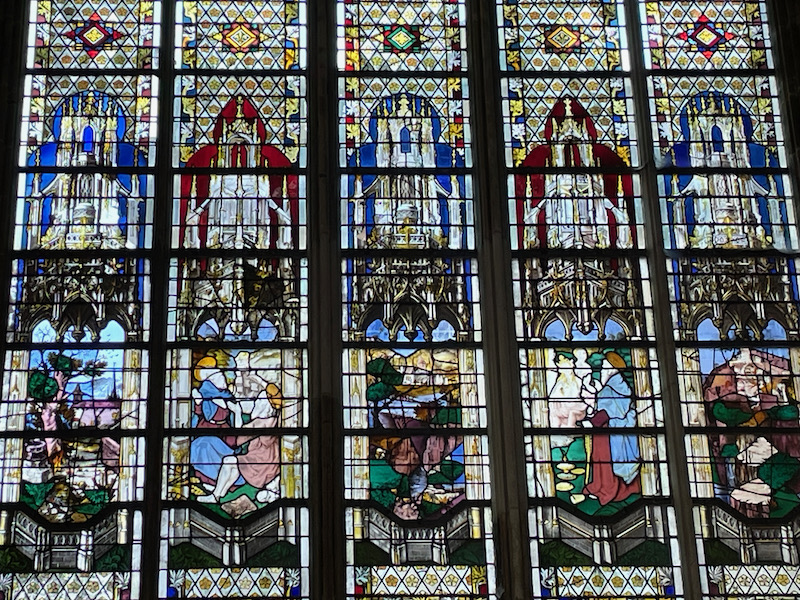
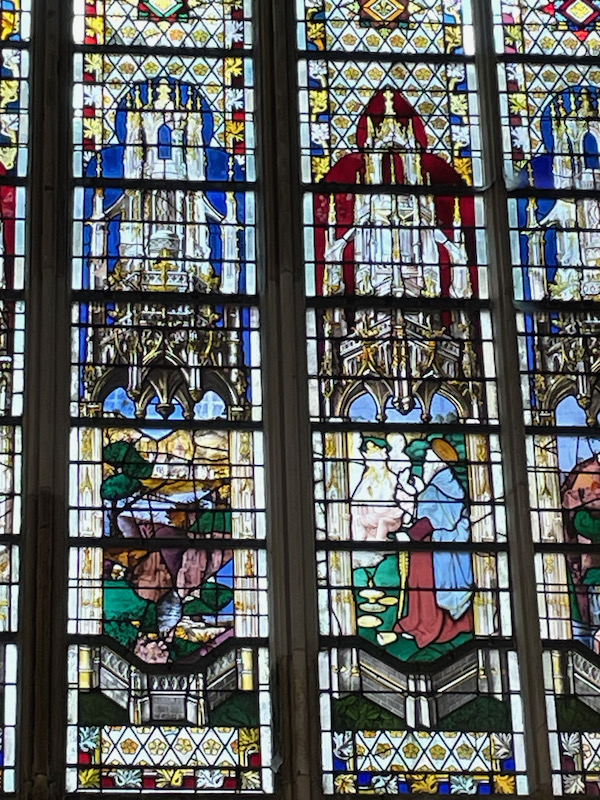
These are the 2 stained-glass rose windows in the transept, made in the late 15th century. One depicts the Tree of Jesse (which we see a lot in churches in France) and in the other, the framework seems to make a star in the middle.
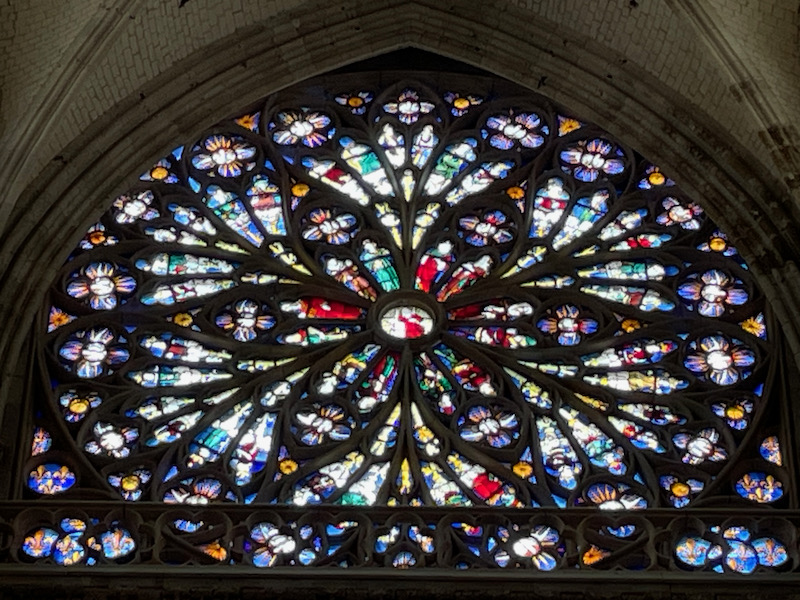
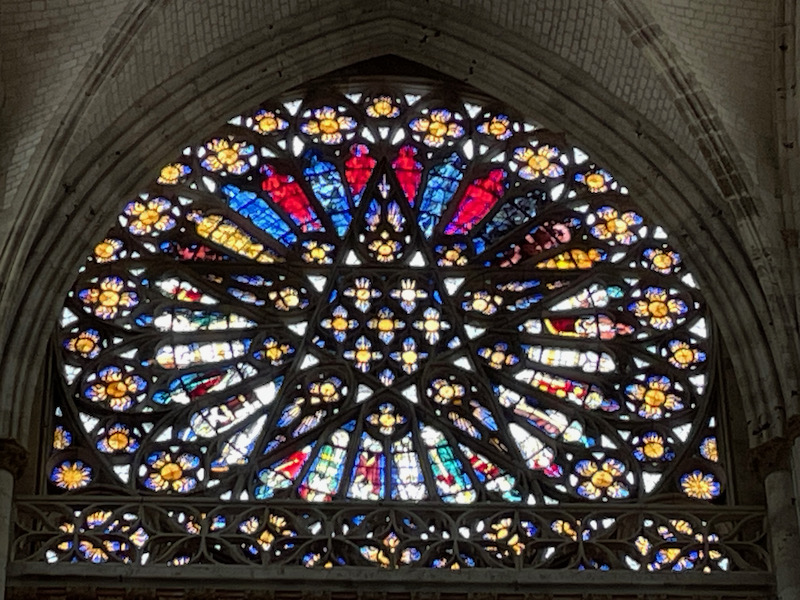
I don't know exactly what this is or when it dates from, but I noticed that there are paintings above the arches in the nave which I thought were nice.
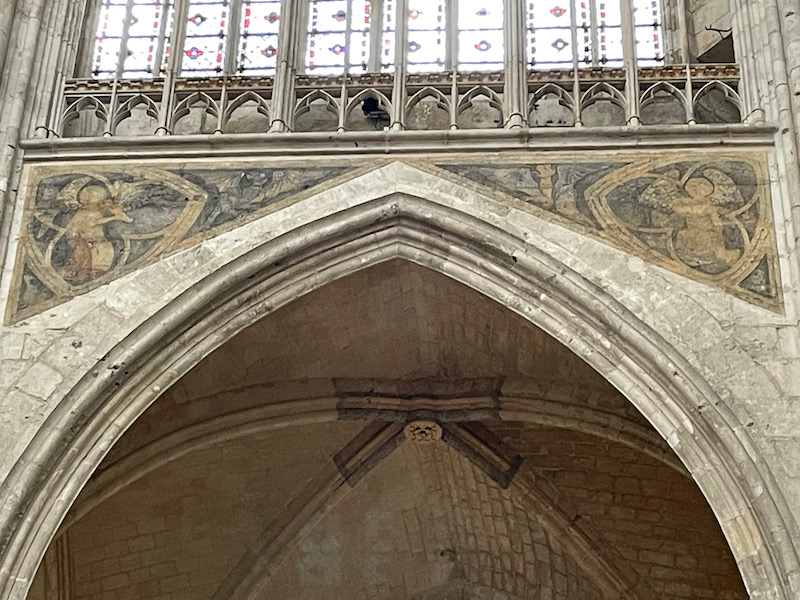
At the very end of the church, this Chapel with a black wrought-iron gate that is quite delicate in nature. They keystones of the Gothic ribbed vaults are colorful (perhaps this is another part that has recently been redone), and a nice altarpiece showing Mary surrounded by 2 angels as well as other statues.
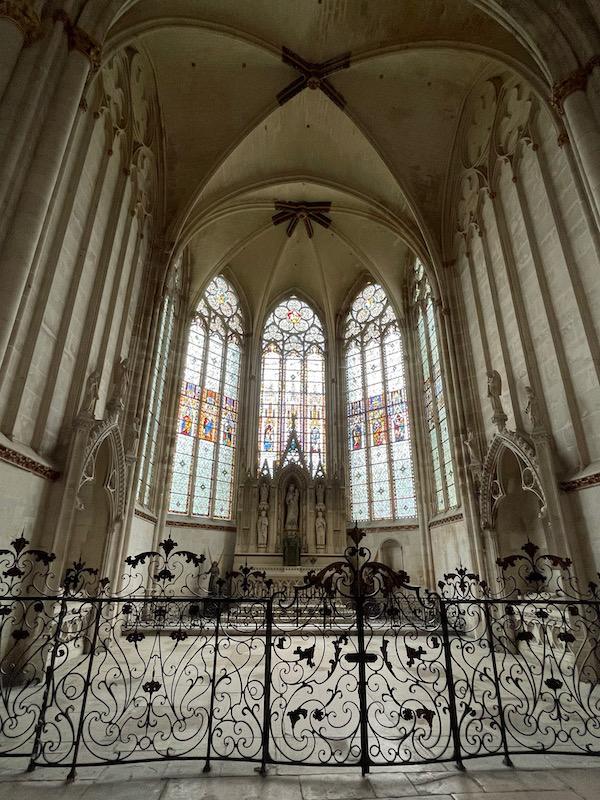
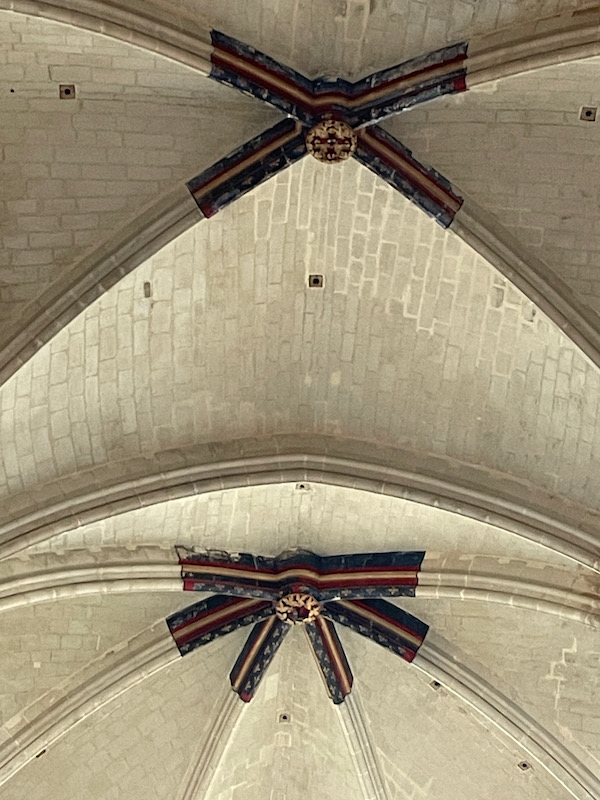
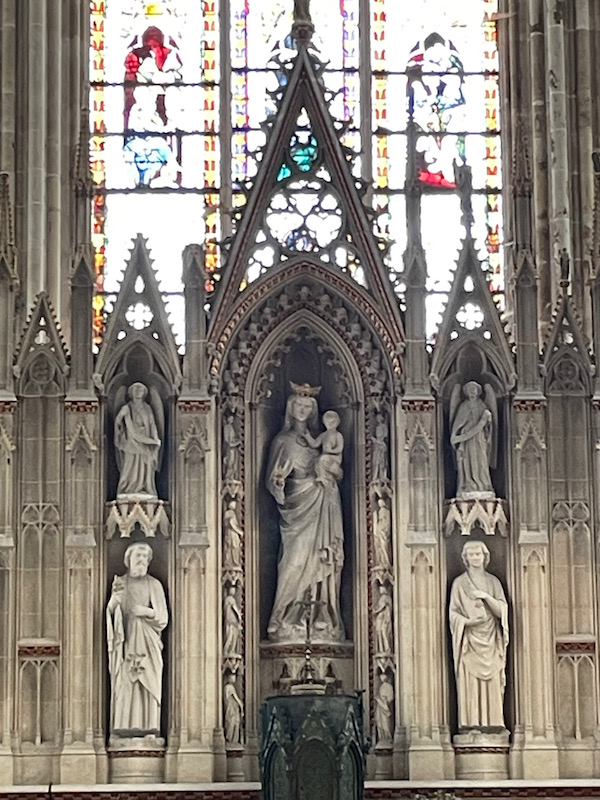
We then headed through the old medieval part of town, and ran across this nice building, dating from 1581.
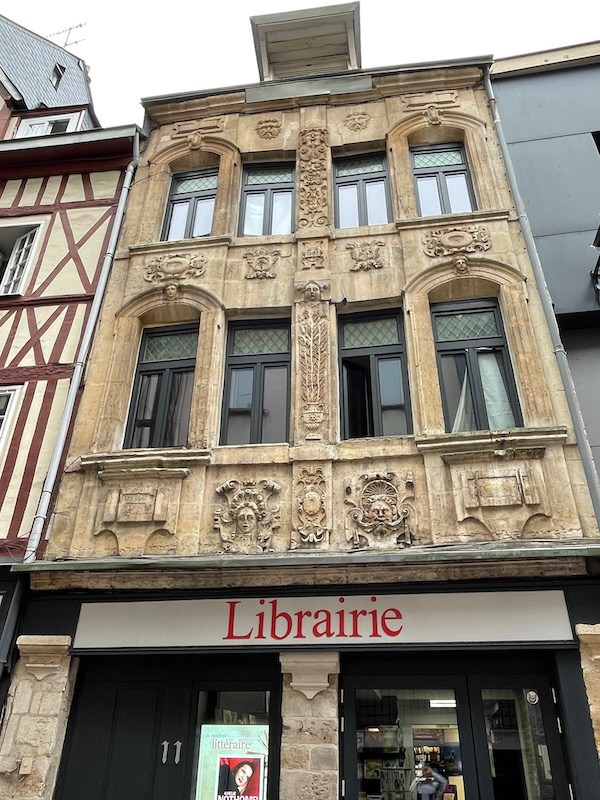
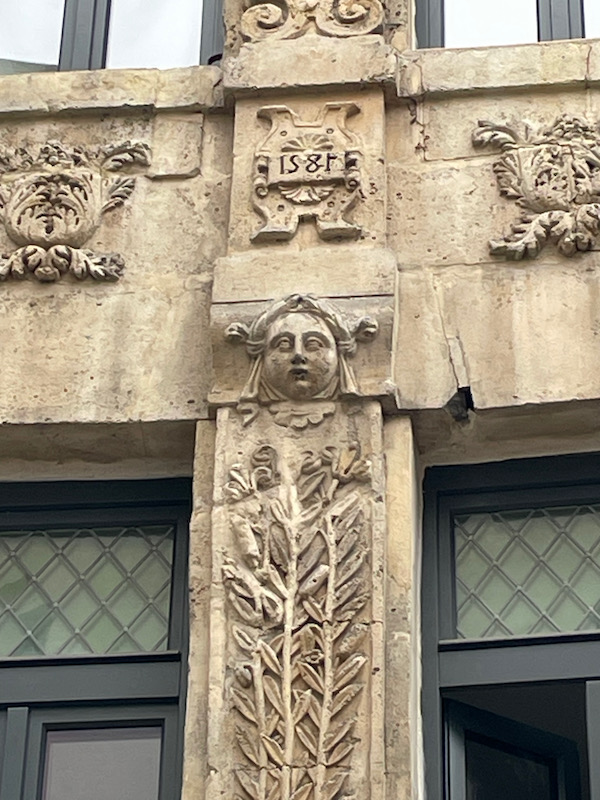
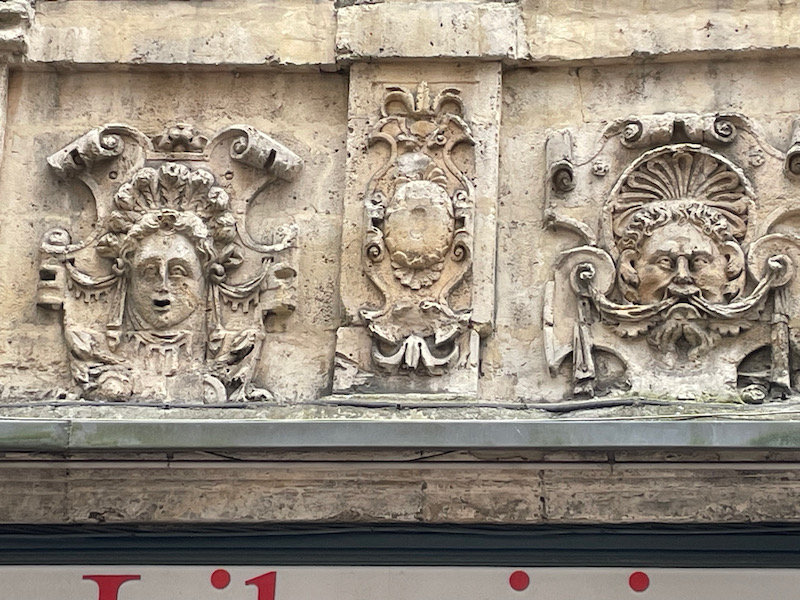
The Palais de Justice was built between 1499 and 1507 to house what would become the Parliament of Normandy under the reign of Francis Ist in 1515. It was turned into a courthouse starting at the French Revolution. It is a HUGE building, having been extended several times ... going on for 3 or 4 city blocks in one direction and 1 block in the other.
The Palais de Justice in Rouen was badly damaged due to heavy fighting in 1944. The building was reconstructed in the late 1940's but the holes caused by the falling bombs were deliberately preserved so that the episode in WWII would never be forgotten. Here you can see those bomb holes on one side of the building. You will also see a couple colored parts. This is a piece of artwork done by a French-German artist named Jan Vormann. The work is called "Dispatchwork Rouen" and it is a bit interesting. It is made up of Lego's but not new Lego's. There was a call out to the kids of Rouen to contribute one of their Lego's for the project, and it was those donated Lego's that make up the artwork. Why Lego's? The artist explained that "I have always sought to improve the appearance of public spaces in various ways, whether through graffiti, collage, etc. As far back as I can remember, I have never appreciated the grayness of cities and I have always wanted to give them back some color. Have you noticed how colorful children's toys are, and paradoxically, how these children, when they are grown up, are content to live in dull homes?"
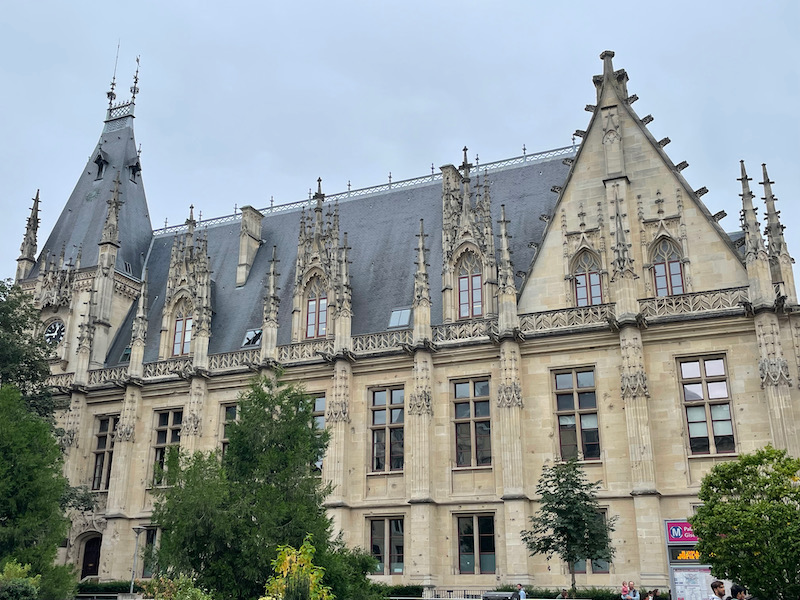
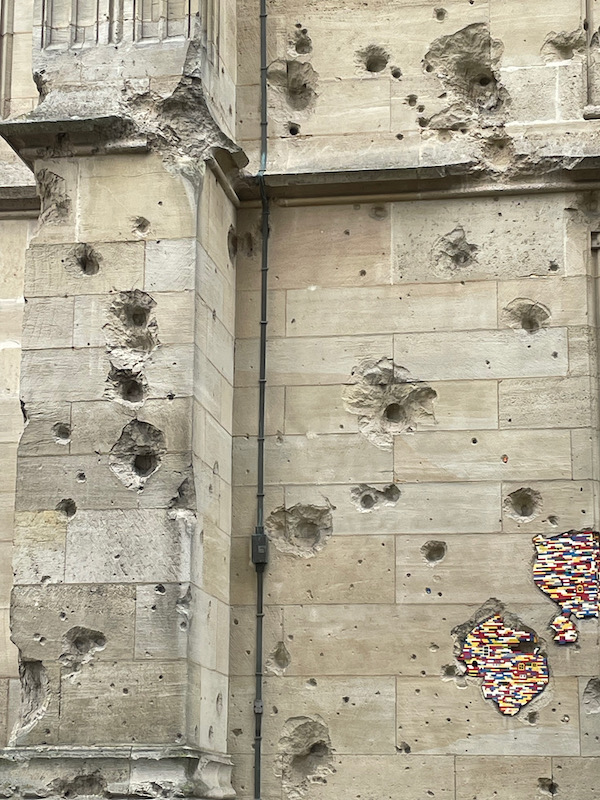
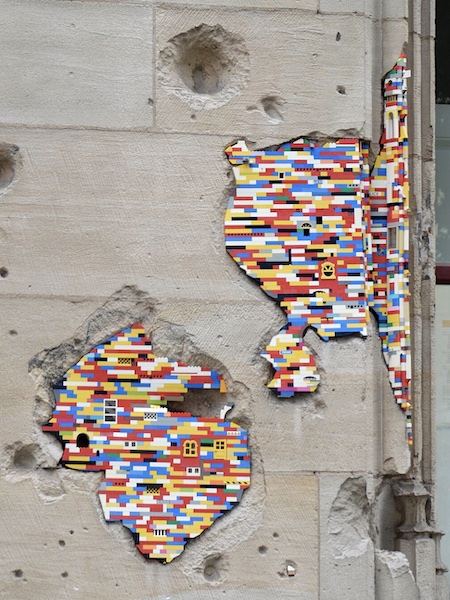
Here you can see the a courtyard and old Royal Palace, which was built between 1507 and 1517 in the Louis XII style. The 3rd picture is the West Wing with one of the staircases going to the courtyard, which was built between 1499 and 1507 in the flamboyant Gothic style. There are staircases on both sides of the courtyard, which were added later and are in Neo-Gothic style. The last 2 pictures are the East Wing, which was built at the end of the 19th century in a Neo-Gothic style, along with its staircase.

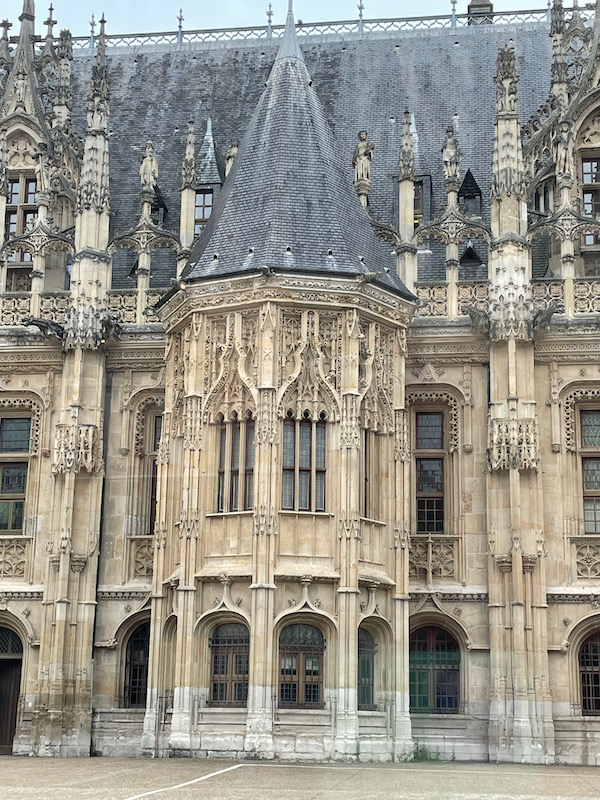
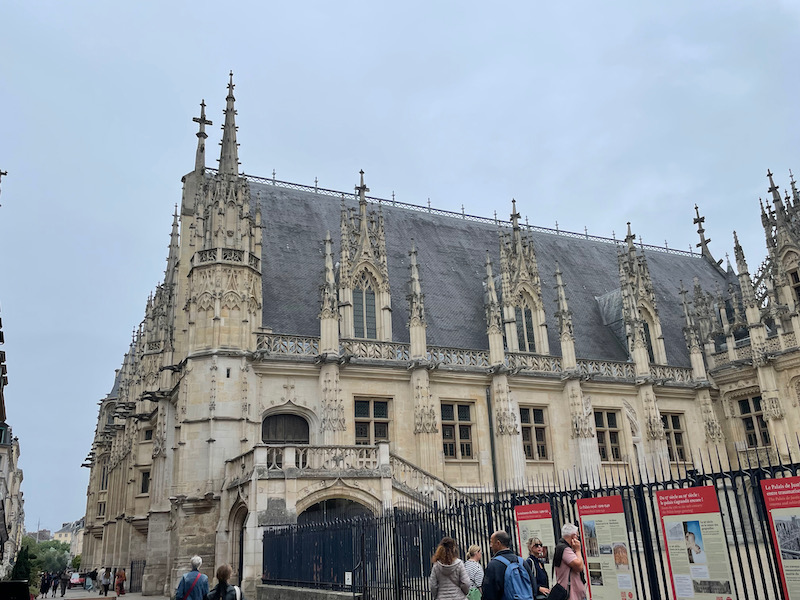
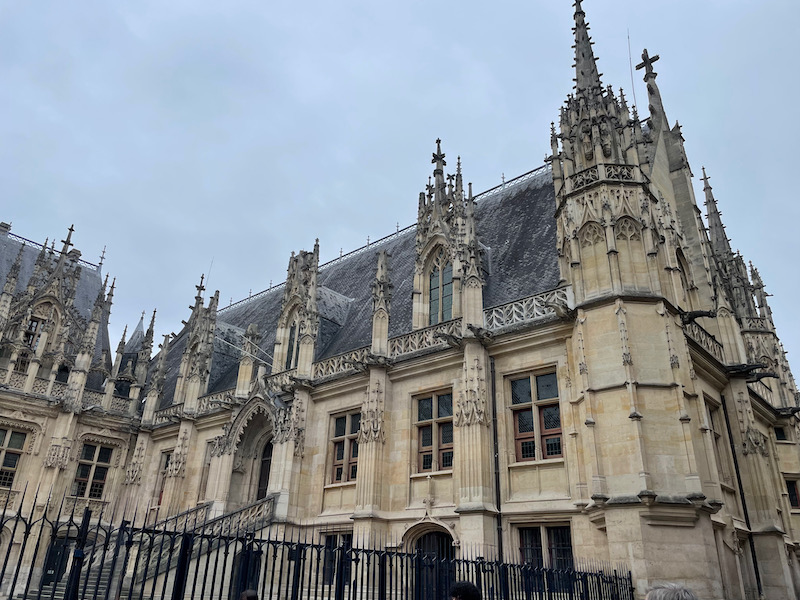
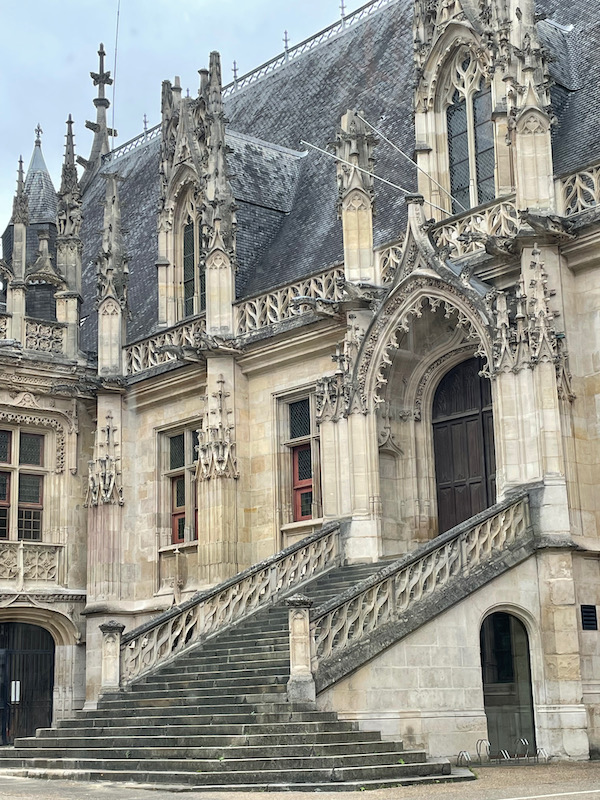
A bit of trivia: in 1976, there was work being done to repair paving in this courtyard. During the work, they discovered a Roman cellar underneath as well as a Roman house from the same period.
We then headed over to the Place du Vieux Marché. There are several half-timbered and corbelled houses there. The old metals halls were demolished in 1973 and a small market now operates next to the Joan of Arch church with a roof that resembles waves of the ocean (which goes well with the Church, which somewhat looks like a fish).
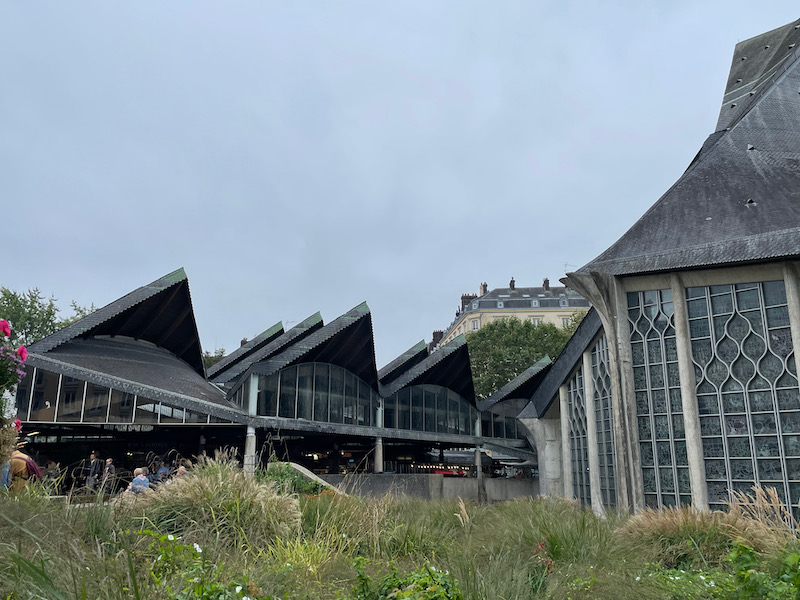
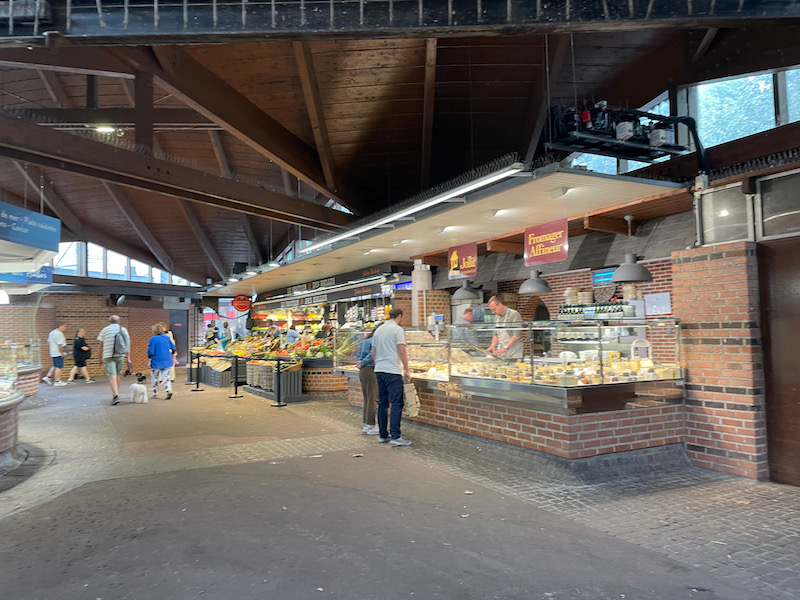
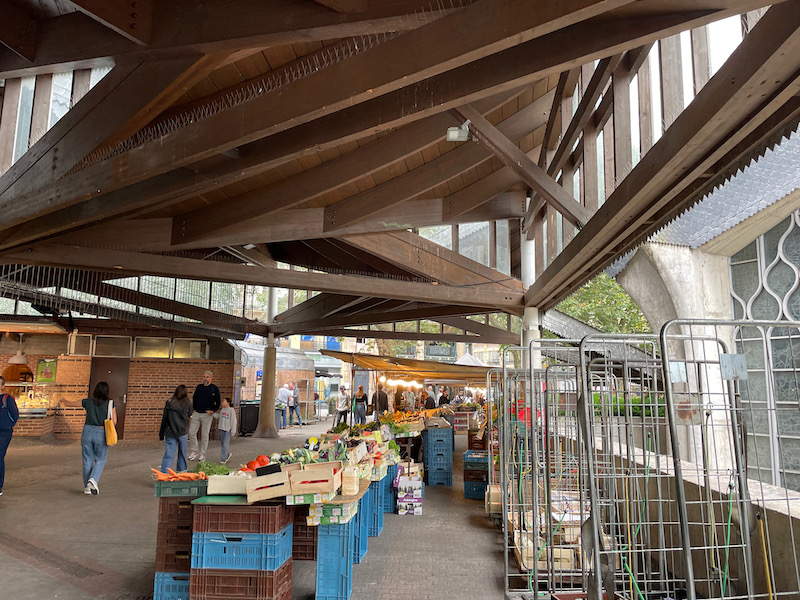
On the other side of the church from the market are the ruins of the old Saint-Sauveur church, destroyed during the Terror in 1794-1795, but whose foundations were uncovered during the renovation of the square. You can also see some of the old buildings behind it.
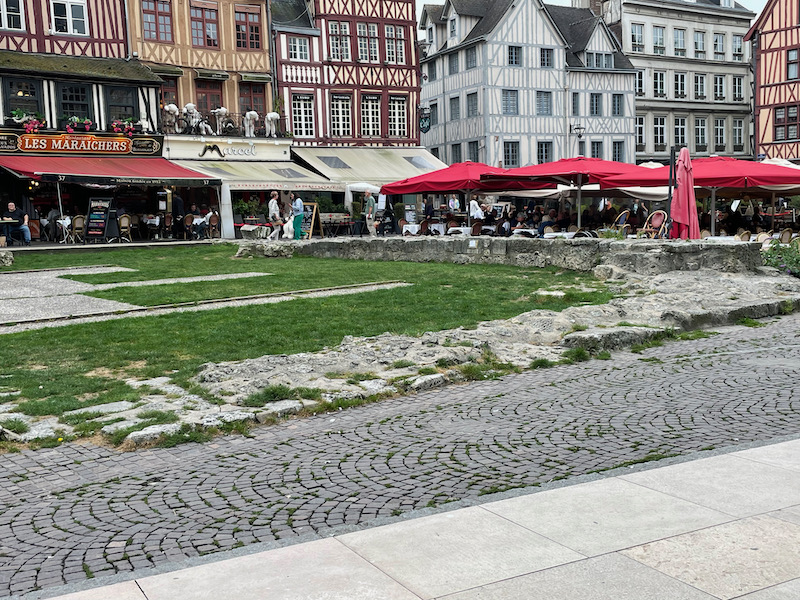
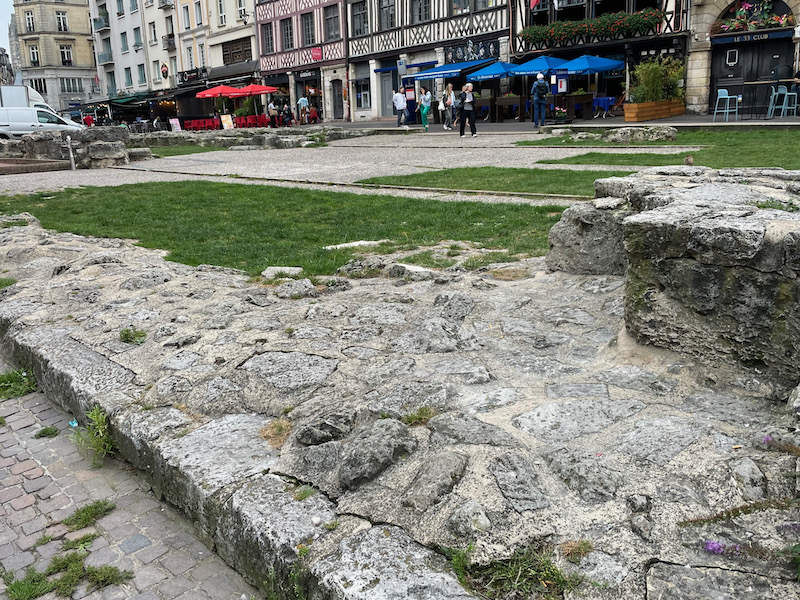
This is the Bistro Marcel, which has all of these white stuffed bears on the façade. I tried to search to determine 'why' they have big white bears but I found nothing.
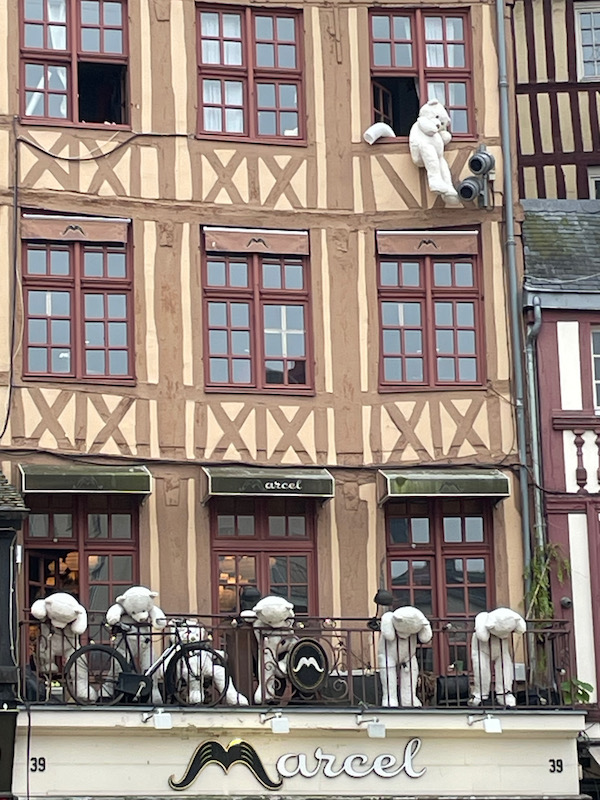
A couple doors down from the bears is La Couronne Restaurant, which was established in 1345, making it one of the oldest restaurants in the country. In 1948, it had the privilege of serving chef and author Julia Child her inaugural French meal. This experience is said to have ignited her lifelong passion for advocating French cuisine.
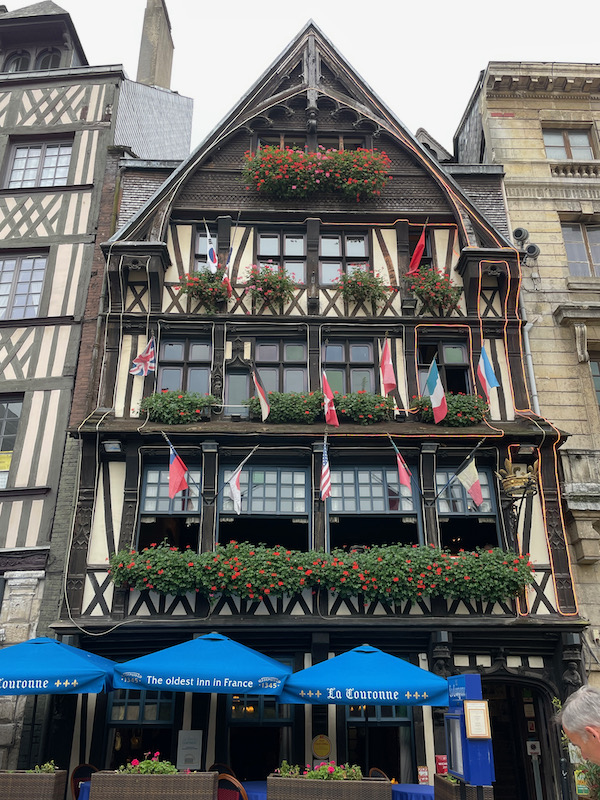
The Church of Saint Joan of Arc is a very modern church, built in 1979 in the location where she was burned at the stake for heresy in 1431. The design is very controversial ... some love it ... some hate it. The sweeping curves of the structure are meant to evoke both the flames that consumed Joan of Arc and an overturned fishing boat. Many early Christian churches were designed in the shape of an overturned boat and some have the ceilings that resemble boat hulls. Personally ... I don't see the "flames" here, it looks to me more like a fish with a long tail.
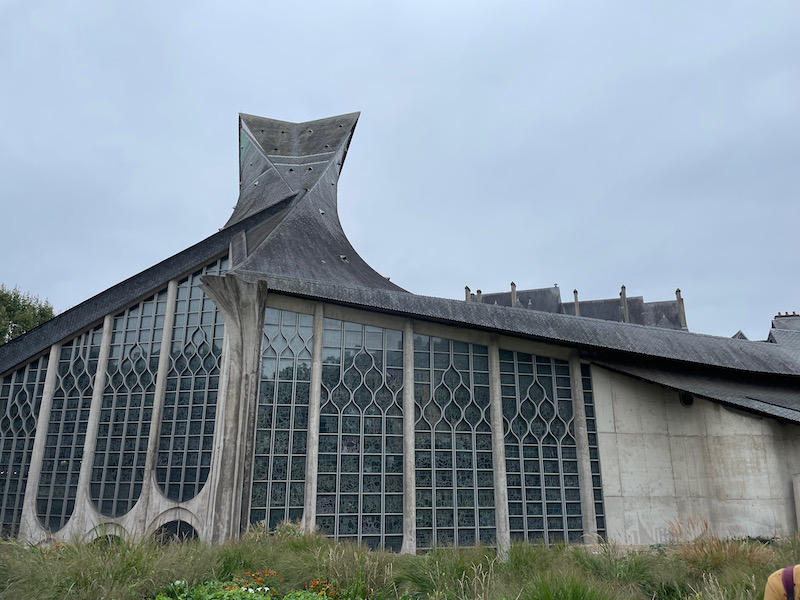
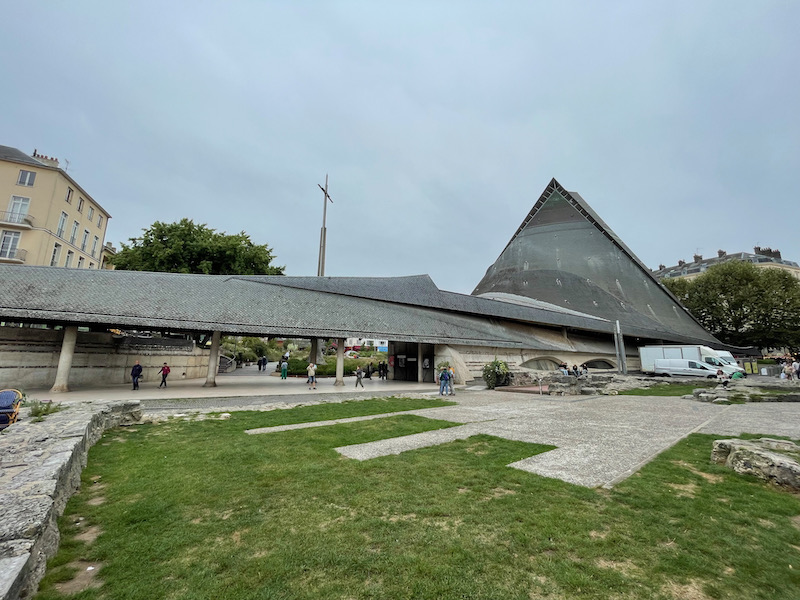
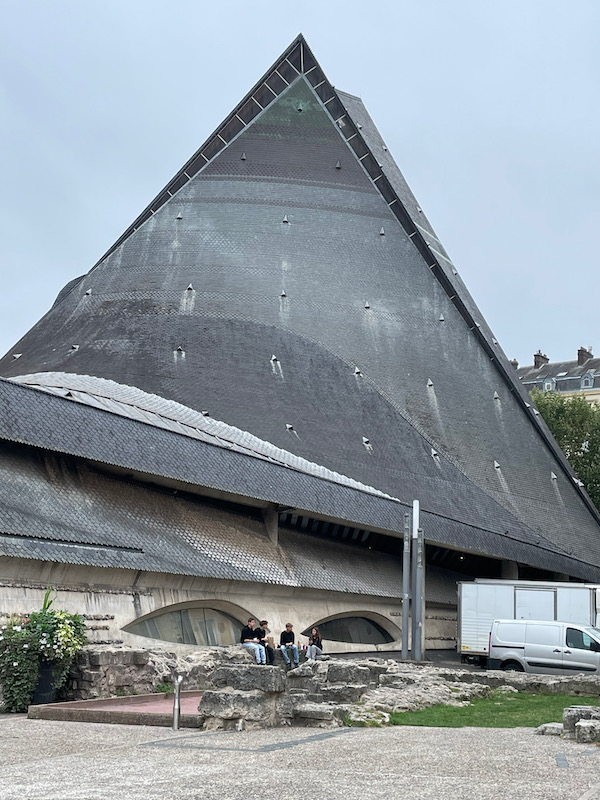
The very tall ceilings are wooden and (to me) look like a fishing boat. But the main thing to see here are the stained-glass windows.
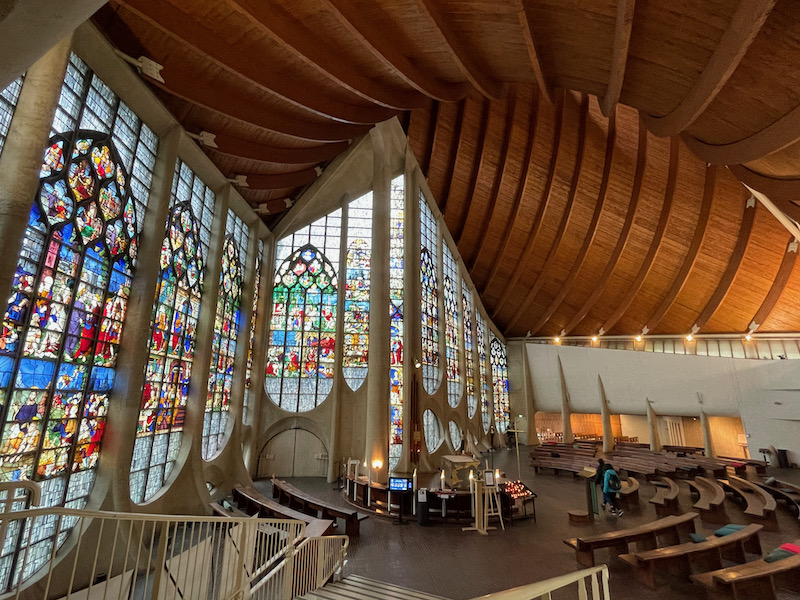
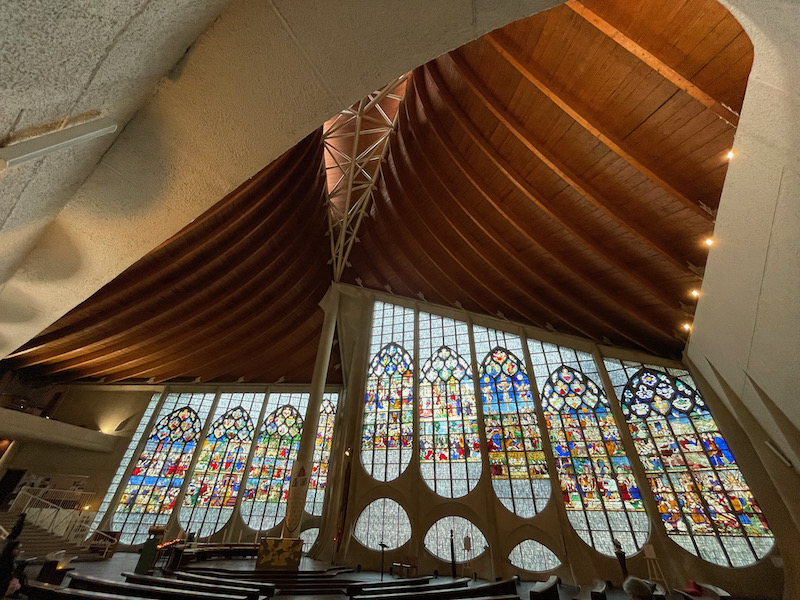
There are 13 stained-glass windows from the 16th century (1520-1530) which come from the old Saint-Vincent church and were moved here. I was trying to take the pictures rather quickly and so, unfortunately, they aren't always from an ideal angle. They also are very "busy", almost all of them with multiple scenes so each scene is somewhat small.
This window depicts the Life of Saint Peter and was done around 1530. The lower register is remarkable for its abundant use of silver yellow in the clothing. The upper register shows the Miracle and Preaching of Saint Peter, Handing over of the keys by Christ, and the Apparition of Christ.
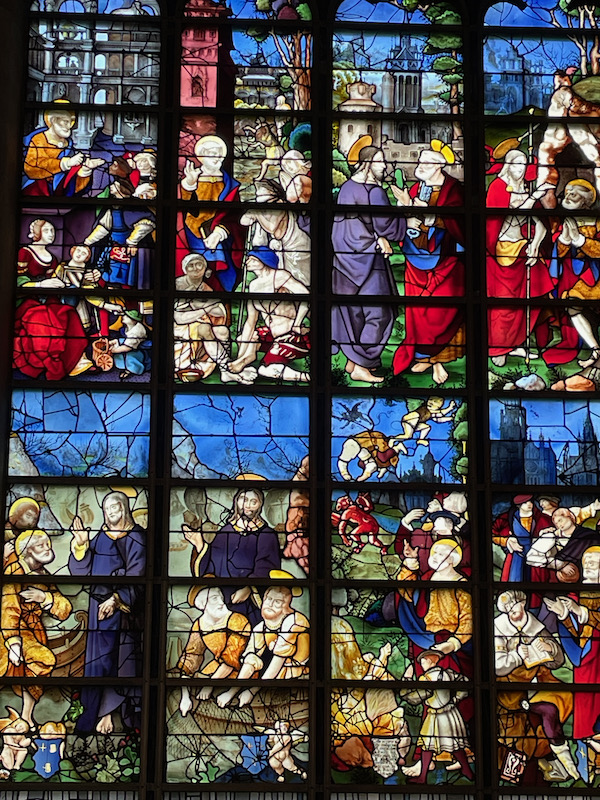
The stained glass window of the life of Sainte Anne which is dated from 1520-1530. It consists of 2 large "paintings" on each register. At the top: the Apparition of the angel to Joachim (upper-left), and the Meeting at the Golden Gate (upper-right_. At the bottom: the Birth of the Virgin (lower-left), and the Presentation of the Virgin in the Temple (lower-right).
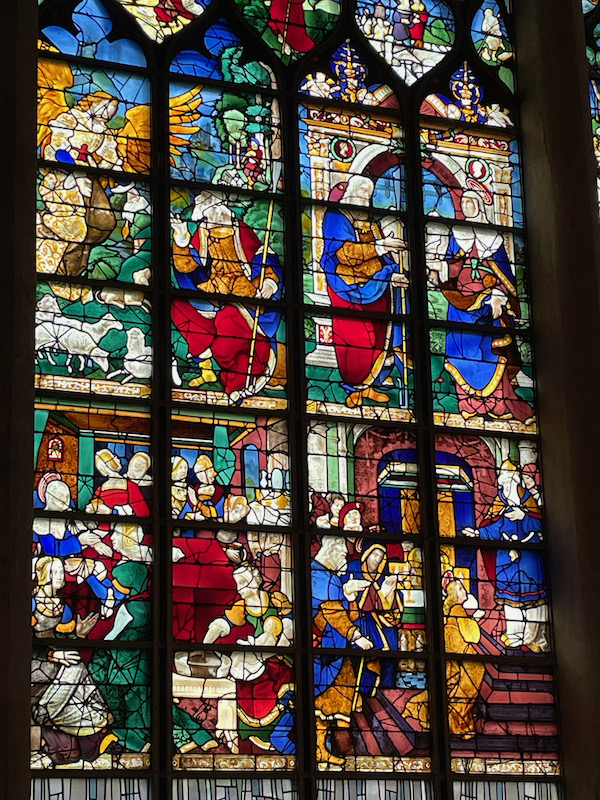
The stained glass window of Saint Anthony of Padua is the only one of the 13 in the old Saint-Vincent church that is painted in grisaille (so a yellow/grey color) highlighted with silver yellow. It is a fairly narrow window and illustrates 3 of the main miracles attributed to this saint.
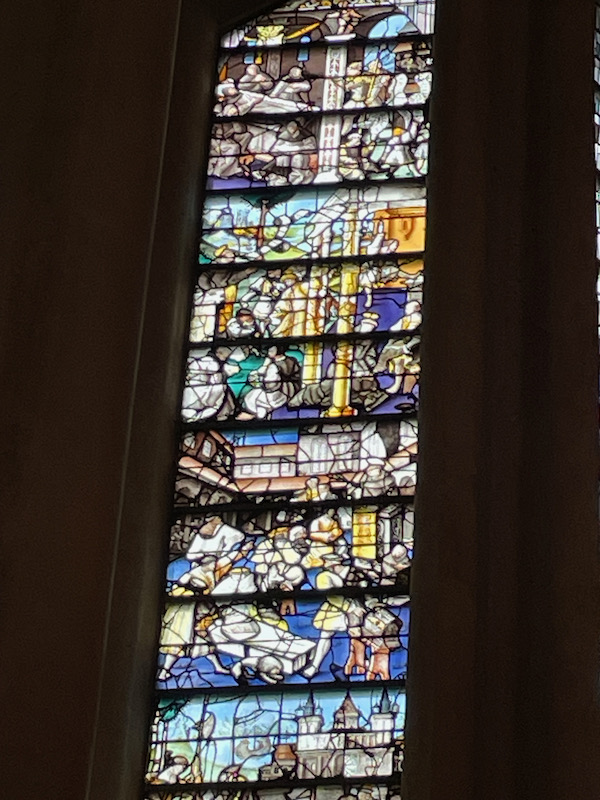
This one is called the stained glass window of the Saints and is also from 1520-1530. It has 3 distinct parts. On the top is Saint Vincent, patron saint of the parish, and Saint James the Greater. The background of this panel is decorated with a very beautiful triumphal arch typical of Renaissance art. The middle shows a saint archbishop (probably Saint Claude) and Saint Nicholas, and then below is Saint Anne instructing the virgin with the donors who funded the window at their feet.
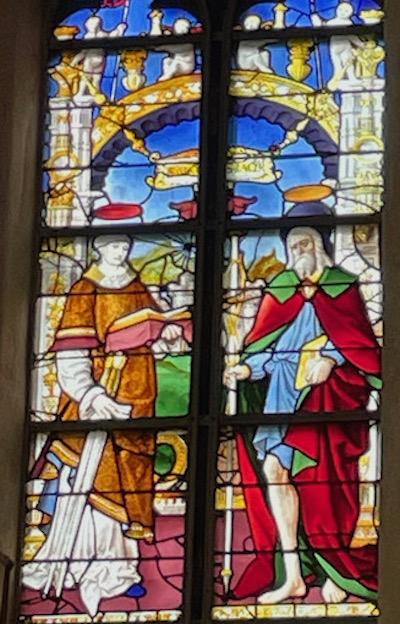
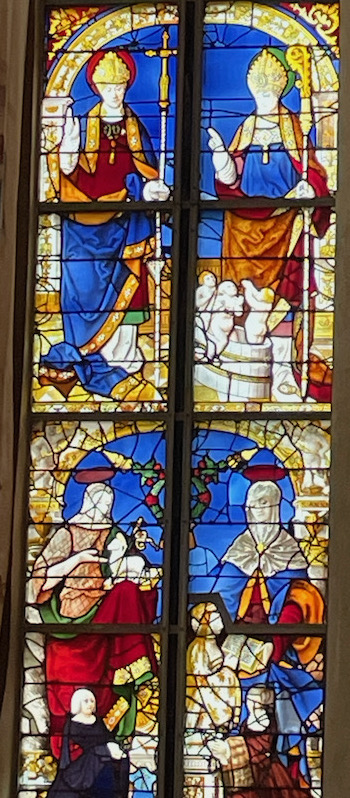
The stained glass window of Saint-Vincent, with the Death of Saint Vincent and the throwing his body of Saint Vincent into the sea at the top, and at the bottom, the Judgement and Martyrdom of Saint Vincent.
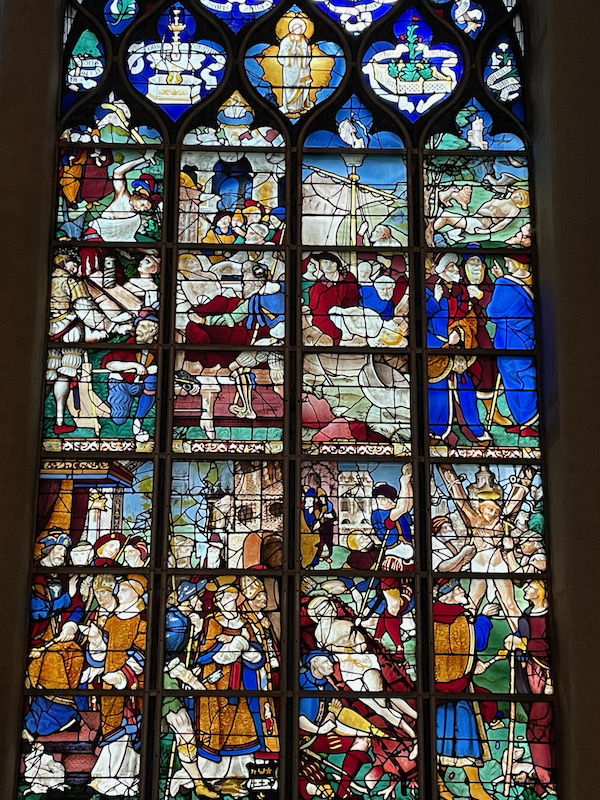
This window is entitled the Glorious Life of Christ. Across the top are 4 scenes: the Descent from the Cross, the Entombment, the Resurrection, and the Holy Women at the Tomb. The bottom also has 4 scenes: Appearance of Jesus to his mother, Apparition to Saint Mary Magdalene, the Supper at Emmaus, and the Incredulity of Saint Thomas.
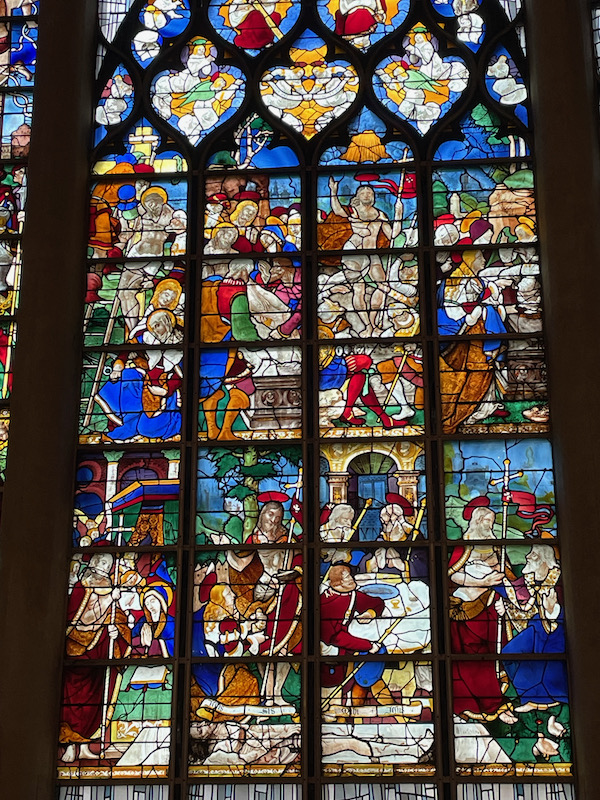
The stained glass window of the Passion, created around 1520-1530, displays the classic scenes of this episode of the New Testament. In the 3rd set of windows from the left on the bottom, you can see Judas, dressed in red, kissing Jesus.
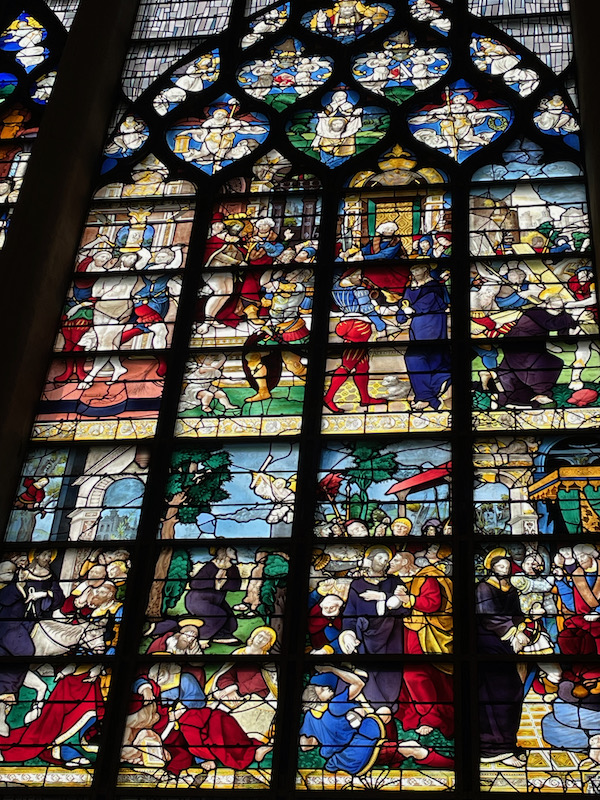
The stained glass window of the Childhood and Public Life of Christ was donated to the parish of Saint-Vincent by one of the great Rouen families, the Roux de Bourgtheroulde. In the upper register, after a Coronation of the Virgin, we find the first stages of the life of Jesus: Nativity, Adoration of the Magi, and Presentation at the Temple. The lower register shows the flight into Egypt, Jesus among the Doctors, Multiplication of the Loaves, and the farewell of Jesus to his mother.
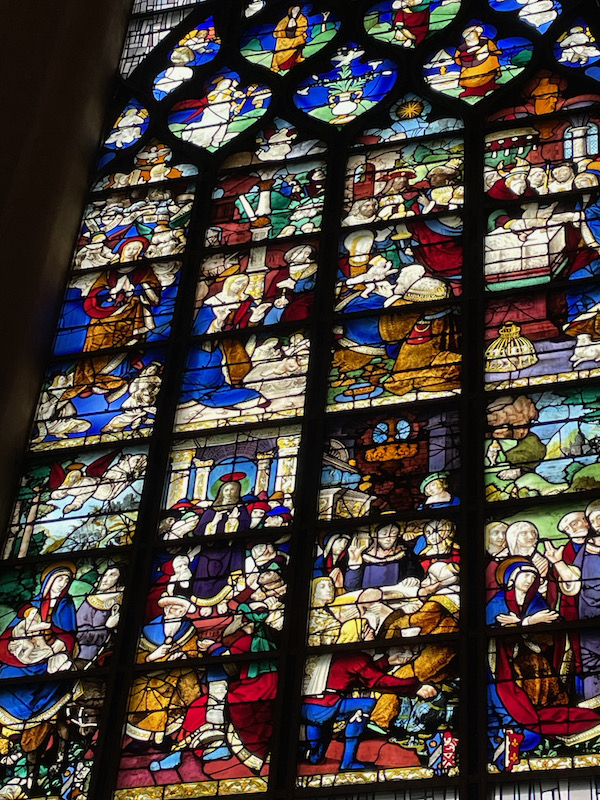
This window depicts the Life of Saint John the Baptist and was made in 1526. The bottom shows the Beheading of John the Baptist (far left, you can see the guy with a sword standing over a person who is bent over) and the Presentation of the Saint's Head to Herod and Herodias.
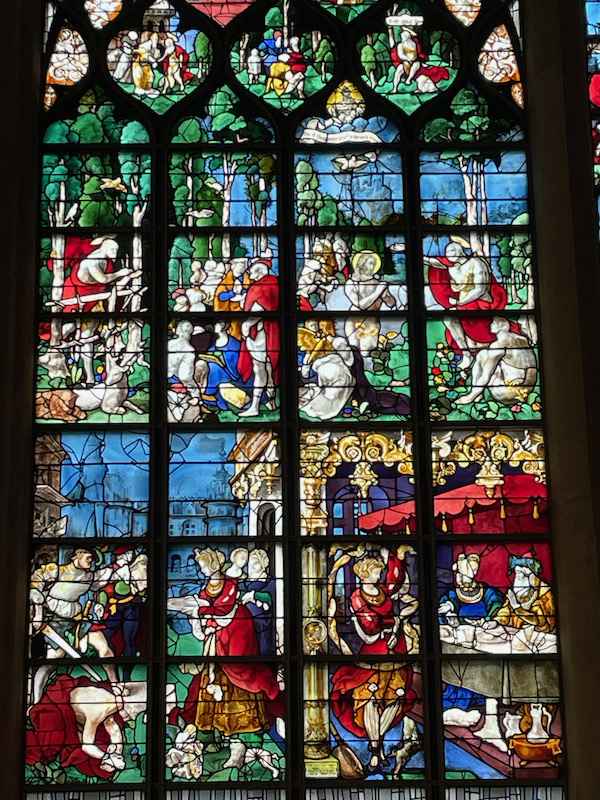
This is the window of the Chariots, commissioned in 1515 and produced around 1522. The Triumph is a chariot pulled by virtues or vices, accompanied by animals and followed by characters embodying Good or Evil, Justice or Envy, Charity or Avarice, etc.
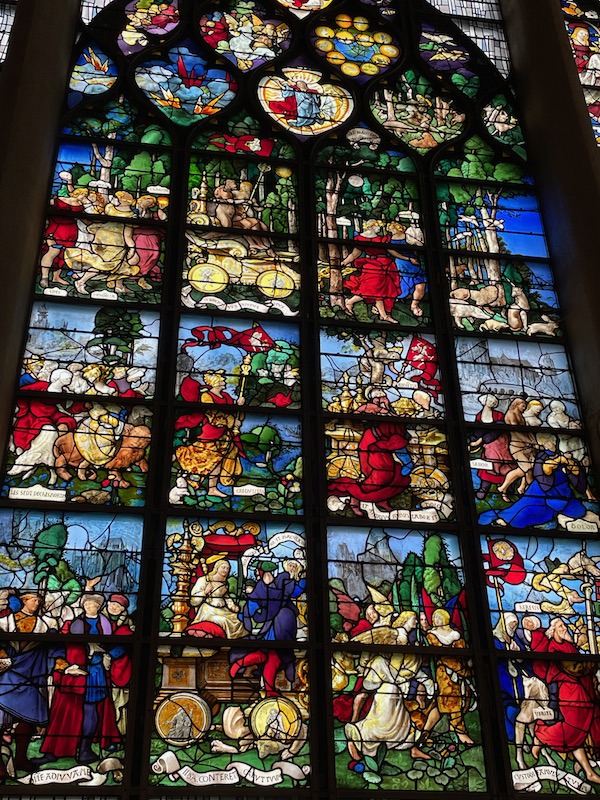
The rue du Le Gros-Horloge, which translates to the street of the Big Clock, is very aptly named since it is the street that goes underneath the big clock. The street is lined with historic half-timbered houses adorned with colorful facades, traditional French bistros, quaint shops, and cafes. The architecture here reflects medieval and Renaissance influence. The great clock dates back to the 14th century and has become a symbol of the city's heritage. It is considered one of the largest surviving clock mechanisms in existence and the same clock face exists on both sides of a Renaissance-style arch. To the right of the clock is a tall belfry with a corner fountain from 1734, which represents a mythological scene illustrating the loves of the river Alpheus and the nymph Arethusa, symbolized by the figure of a Cupid flying above them.
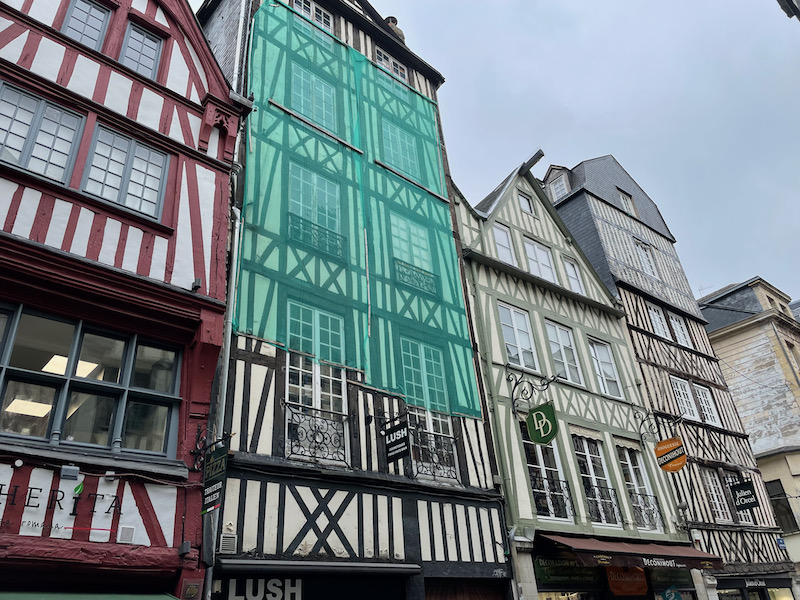
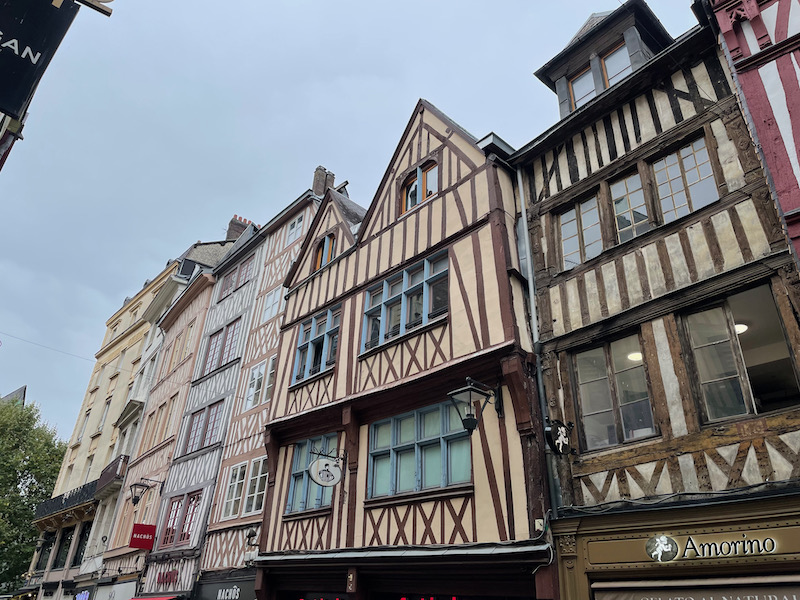
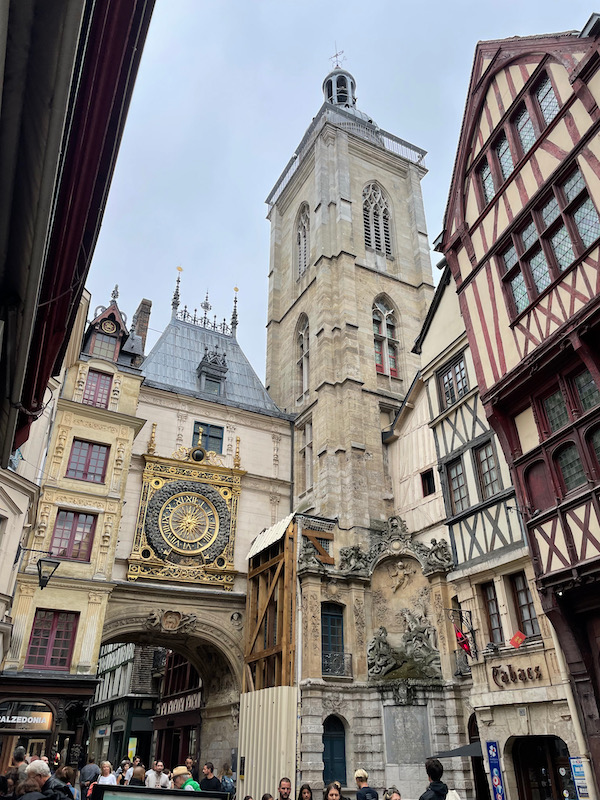
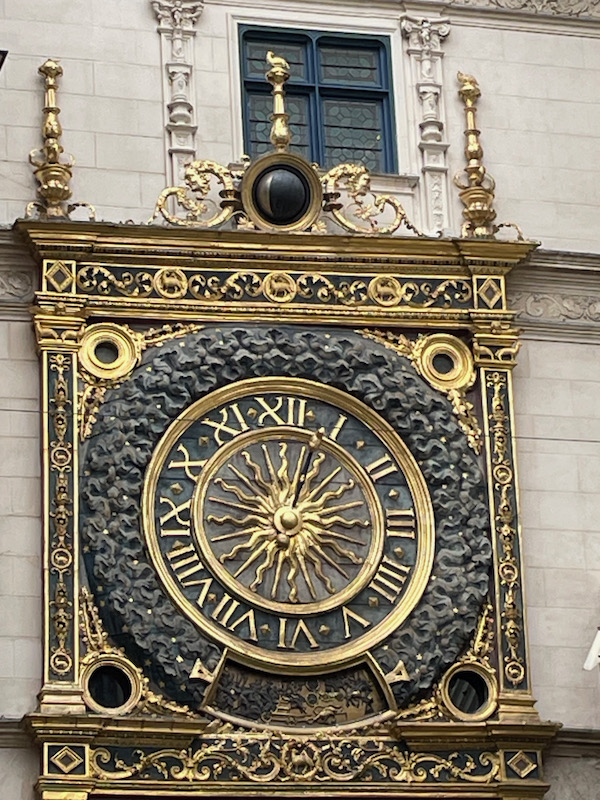
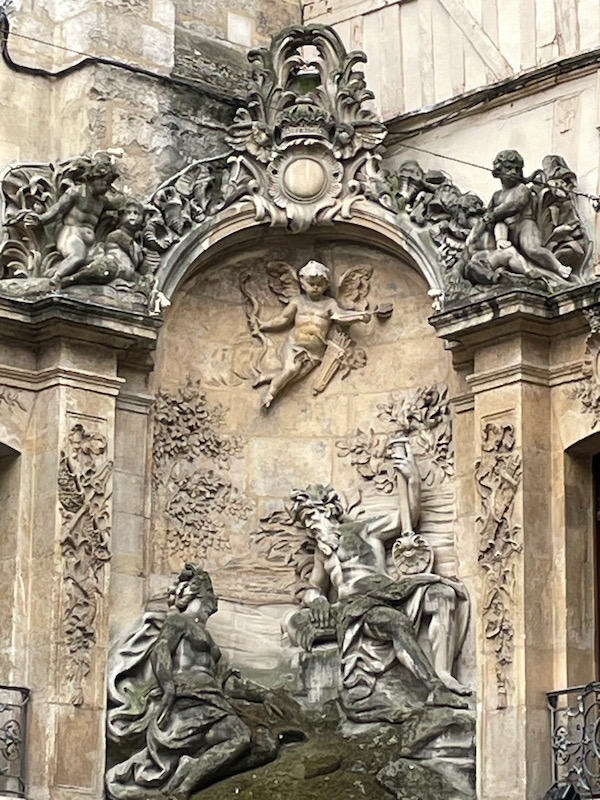
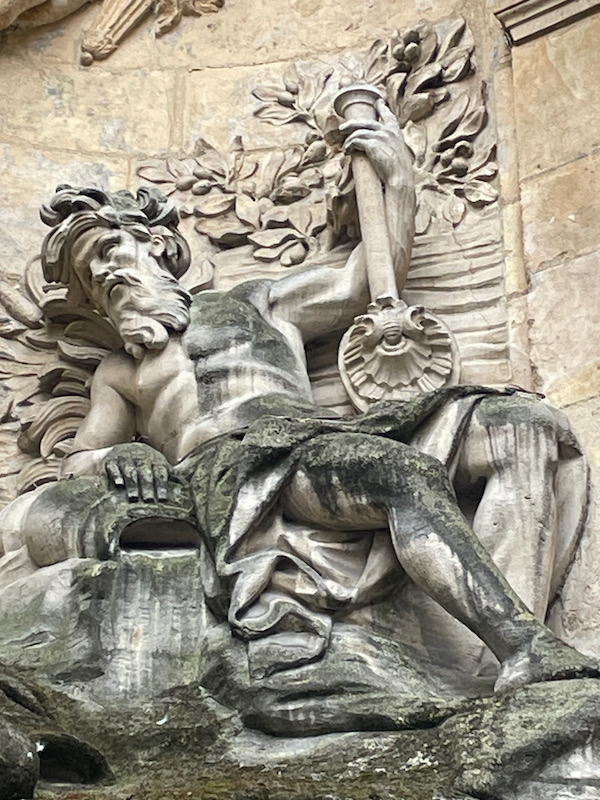
The Renaissance arch was built between 1527 and 1529. You can see the coat of arms of Rouen, a lamb carrying a cross, over the arch. The underside of the vault is richly sculpted showing Christ as the Good Shepherd.
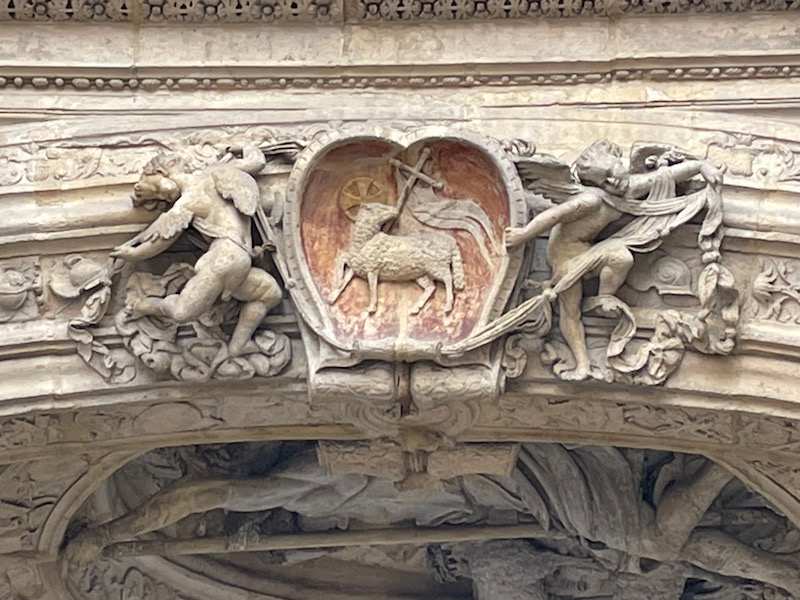
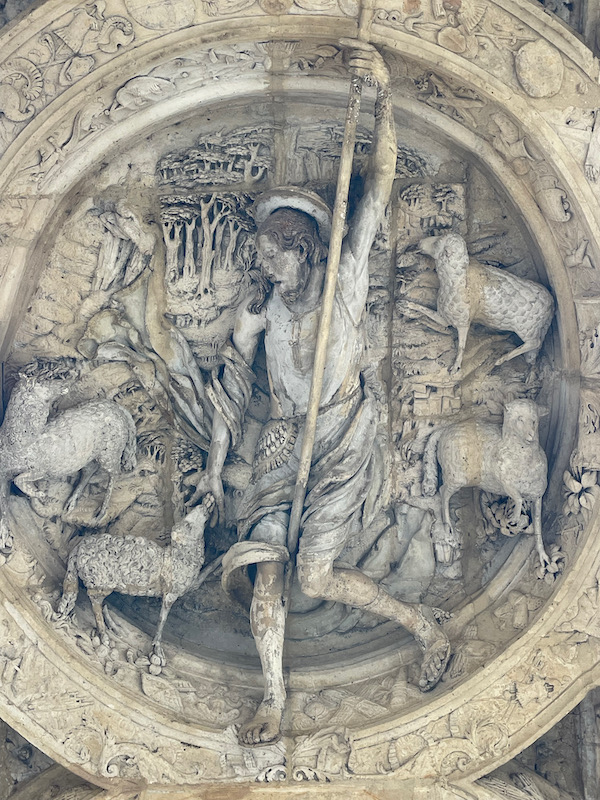
Christianity was established in Rouen in about 260 by Saint Mellonius, who became the first bishop. The first church is believed to have been under or close to the present cathedral. Multiple buildings were built and enlarged with a large Romanesque style church being consecrated in 1063 in the presence of the future William the Conqueror, who was the Duke of Normandy at the time. The church was changed to Gothic style in the mid-to-late 1100's, after the Archbishop of Rouen, Hugues of Amiens, attended the consecration in 1144 of the Gothic-style Basilica of Saint-Denis.
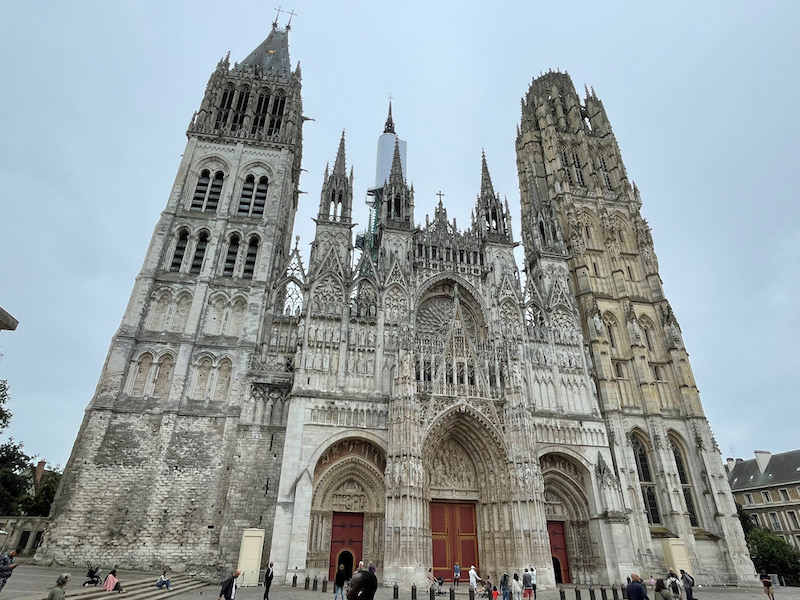
The west front of the Cathedral, with its three portals, is the traditional entrance to the Cathedral. The portals are aligned with the three aisles of the nave. The west front was first built in the 12th century, entirely redone in the 13th century, and then totally redone again at the end of the 14th century, each time become more lavishly decorated. I tried to get a couple close-ups to show the intricate flamboyant-Gothic decoration.
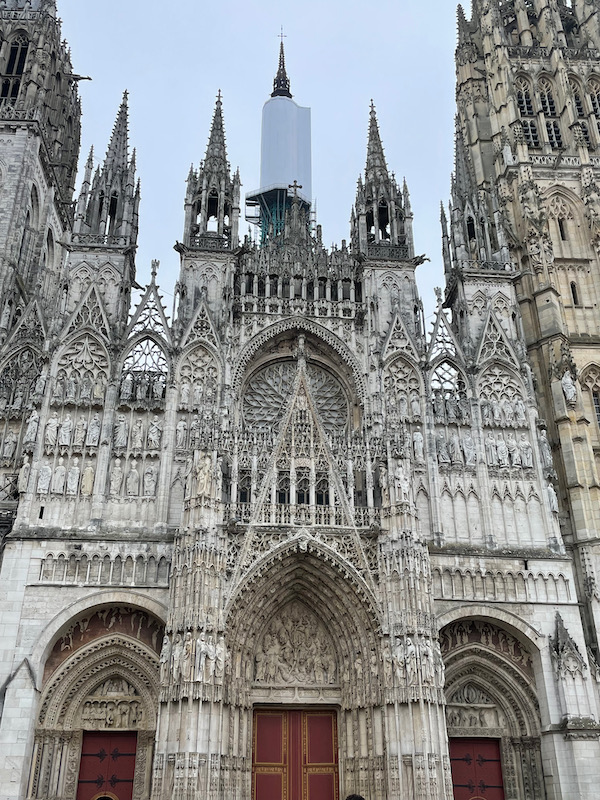
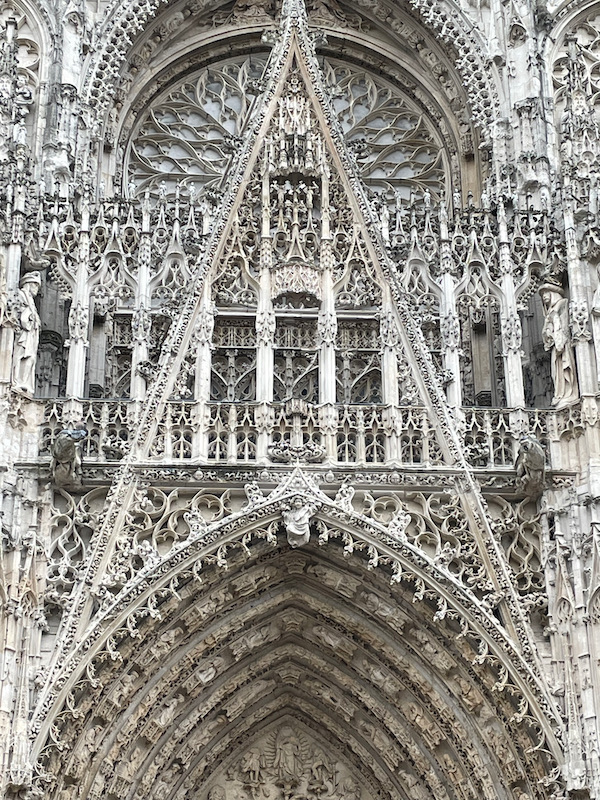
The central sculptural element of the tympanum is a Tree of Jesse, a common depiction of the family tree of Christ. This one, however, is one of the rare representations of this theme that has been done out of stone.
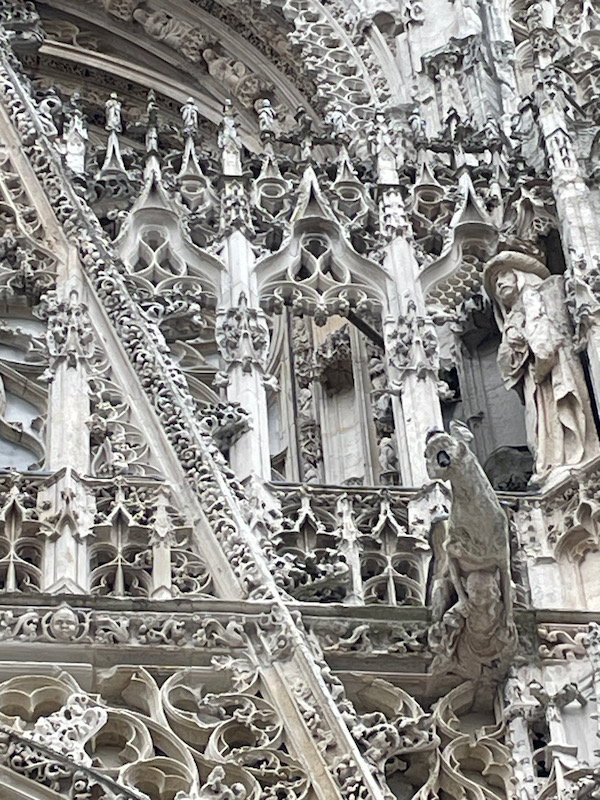
There are sculptures of Apostles on the North Buttress.
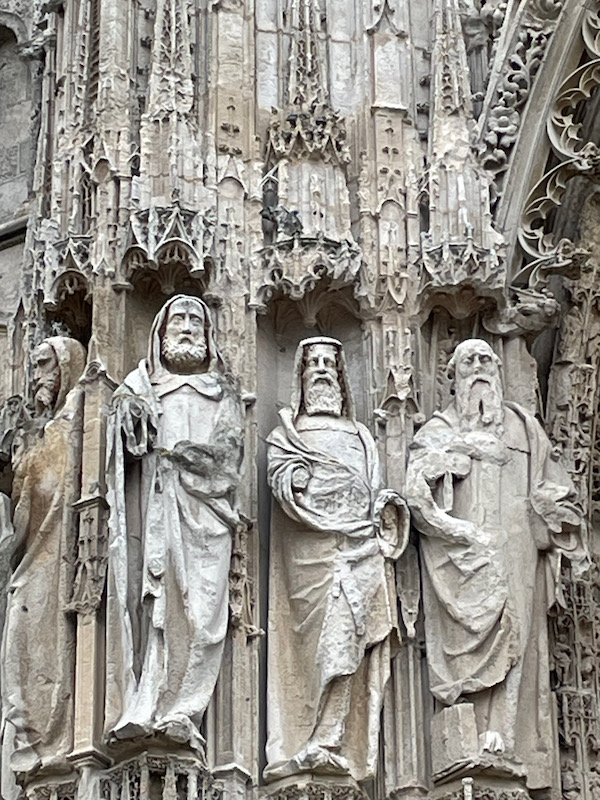
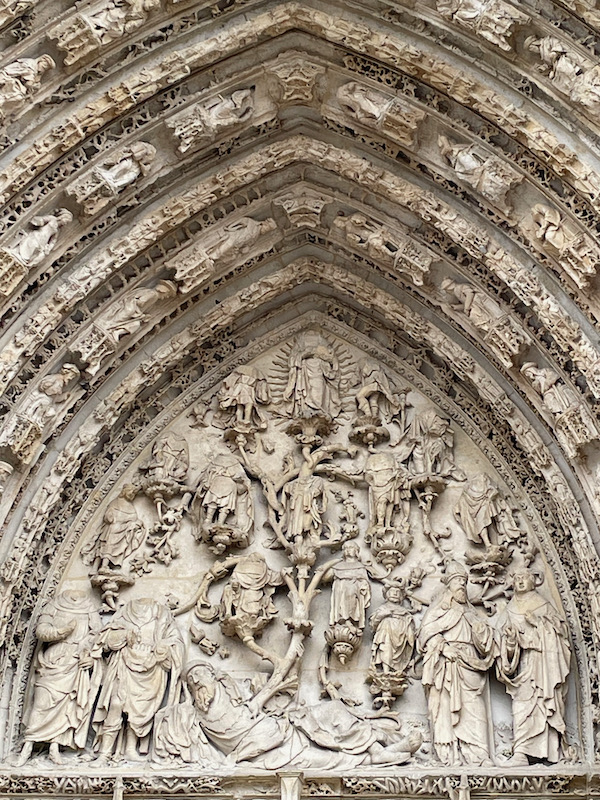
The Saint-Romain tower, on the left, was begun in 1145 as part of the original Gothic cathedral. The top of the tower, more decorative, was added in the 15th century. If you look closely, you can clearly see how the bottom part of the tower is made of different size stones than the upper parts and also different from the center portion to the right of it.
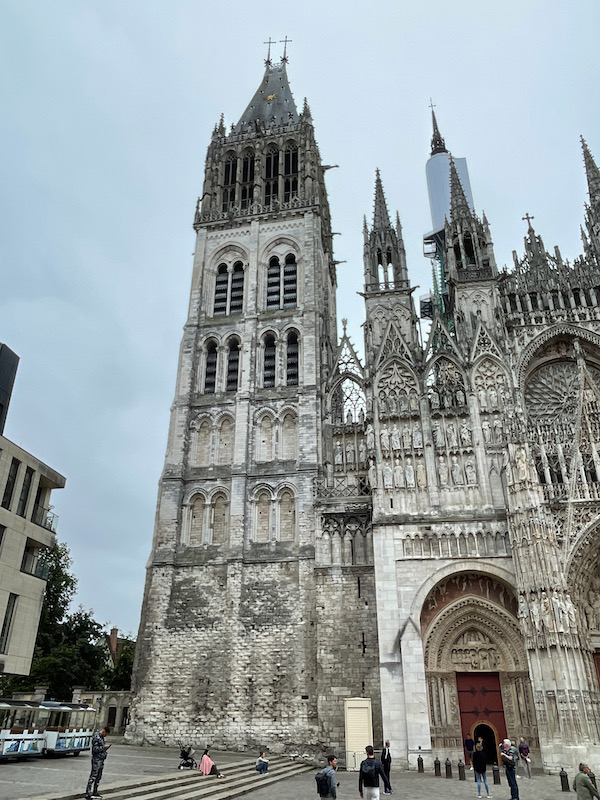
The Butter Tower, on the right, was constructed between 1488 and 1506, in a late Gothic Flamboyant style. It received its popular name because donors to the tower were given dispensation to consume butter and milk during Lent.
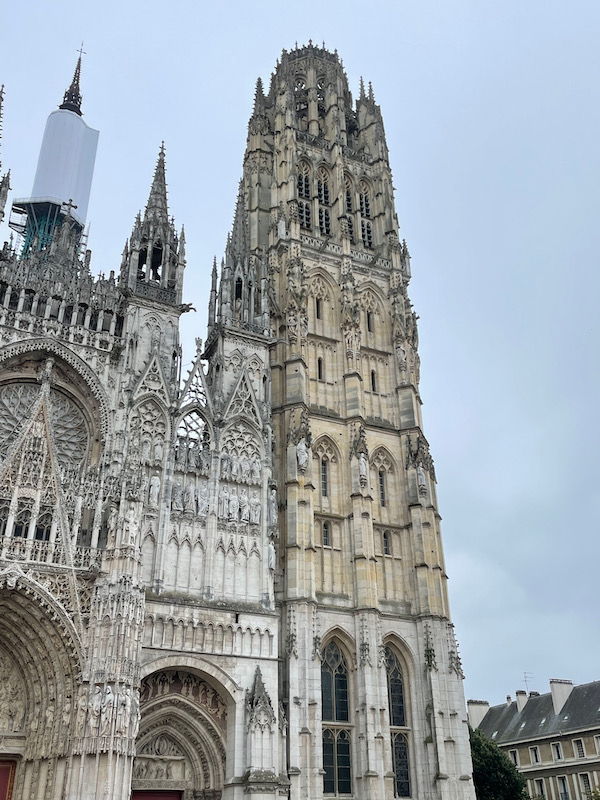
Sometimes we talk about the damage from WWI and WWII in France, Belgium, and Germany, and Rouen is no different. At the beginning of WWII in 1939, remembering the damage caused to French cathedrals in WWI, the Cathedral authorities protected the sculpture of the cathedral with sandbags and removed the old stained glass and transported it to sites far from the city. That was a good idea, since the church was hit by several Allied bombs (both American and British) hit the church. It was restored and reopened in 1956. It is famous for the paintings of the cathedral that were done by the Impressionist artist Claude Monet, who produced a series of paintings showing the same scene at different times of the day and in different weather conditions.
The nave has 11 bays separated by pillars and a tall vaulted ceiling. There are chapels on the both sides. Then up at the choir, you can see the continuation of the Gothic pointed arches around apse.
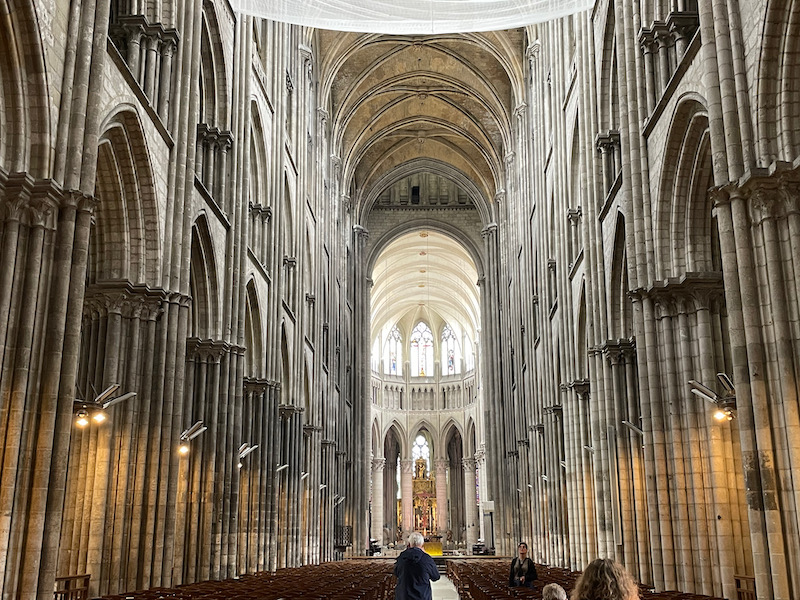
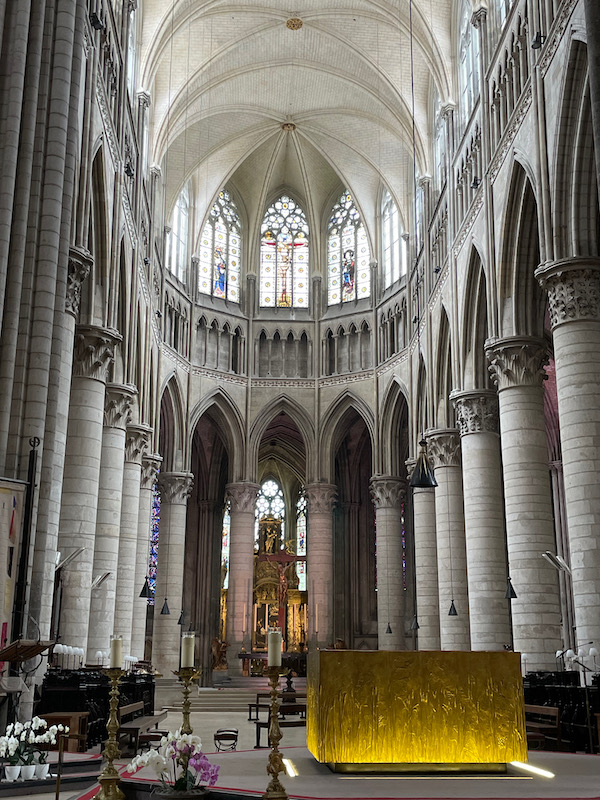
The north transept contains a monumental staircase, known as the "Librarians' Staircase" because it gave access to the library. The first two flights were built in 1479 and the next two were added in 1788 while respecting the initial Gothic style.
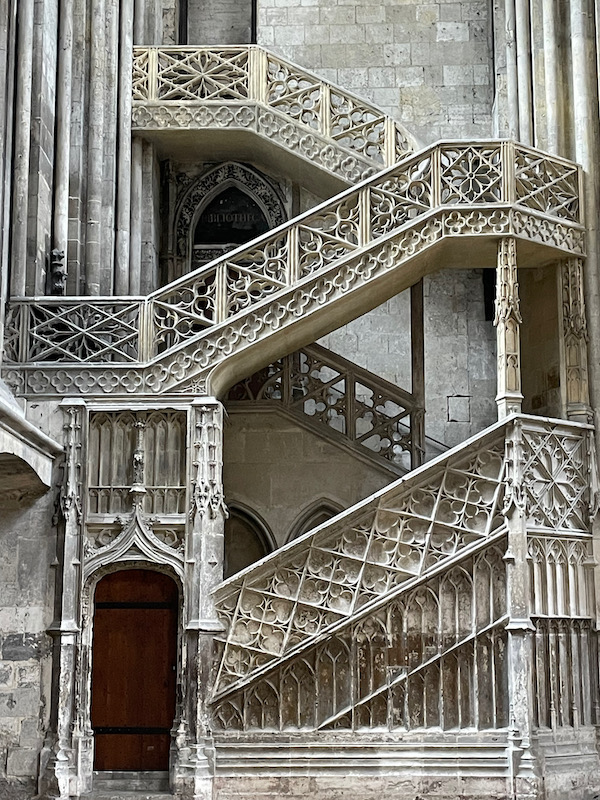
The Chapel Saint-Sever has stained glass windows from the early 13th century, called the "Belles Verrières". Four scenes from the Passion of Christ are represented there. The rest of the chapel is not all that interesting, so I only have the stained-glass windows.
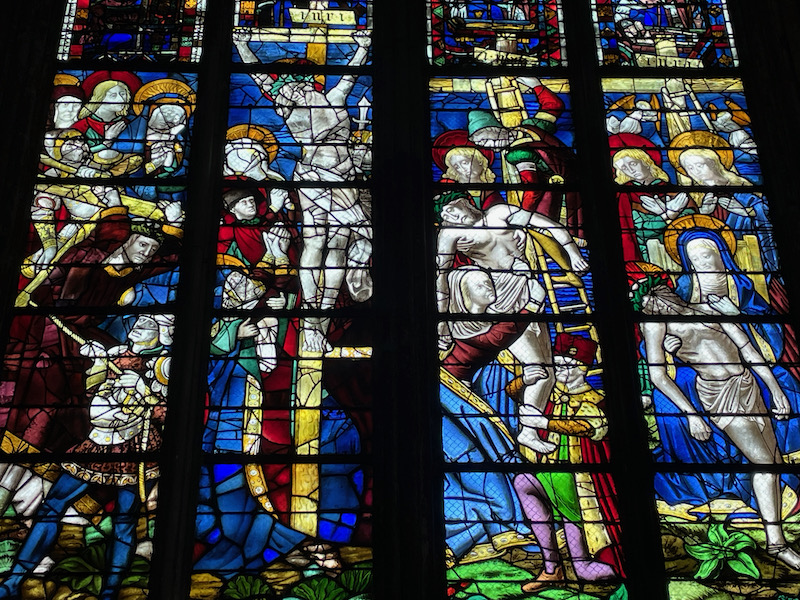
Chapel of the Blessed Sacrament has an interesting altar with the bas-relief of the Pilgrims of Emmaus in the base. The stained-glass windows date from the 13th century (1230) and they were the start of a new artistic design for windows. The intent was to get more light into the church, and this was done by mixing clear/white glass with fewer colored scenes. donor before a holy king, circa 1230. This chapel (formerly called the chapel of Saint-Jean-Jouxte-les-Fonts) launched this new form, called "mixed". The windows were remade identically in 1958-1960 after WWII. You can see the difference between these two windows and the ones above and below, which were done prior to this new style.
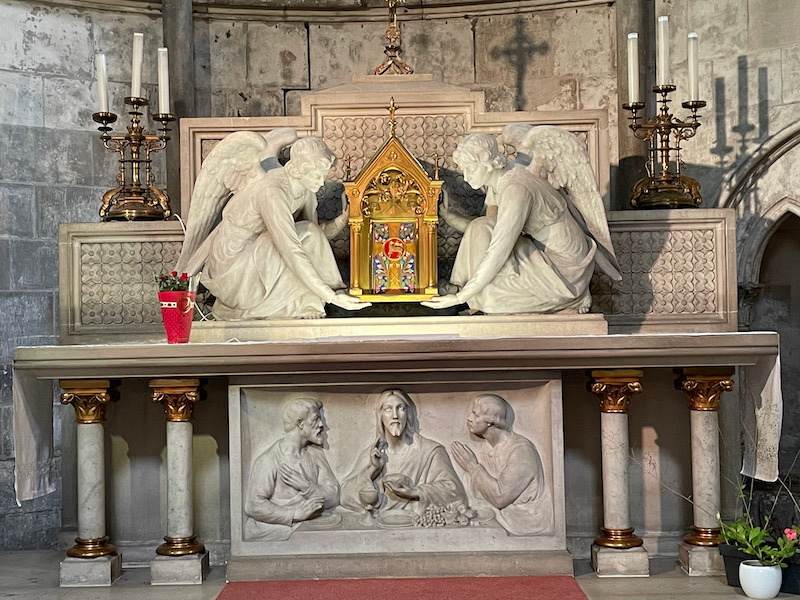
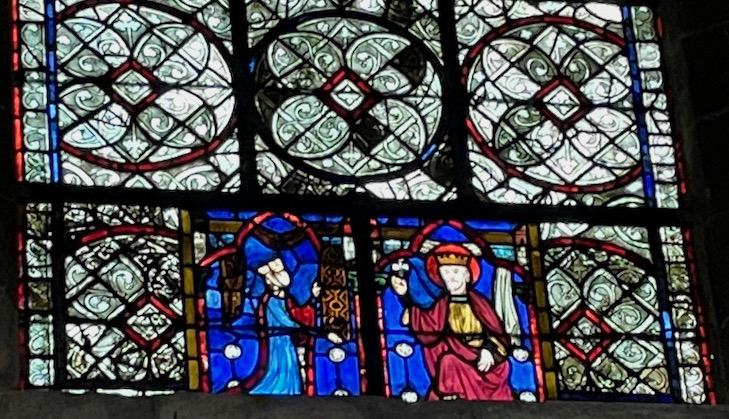
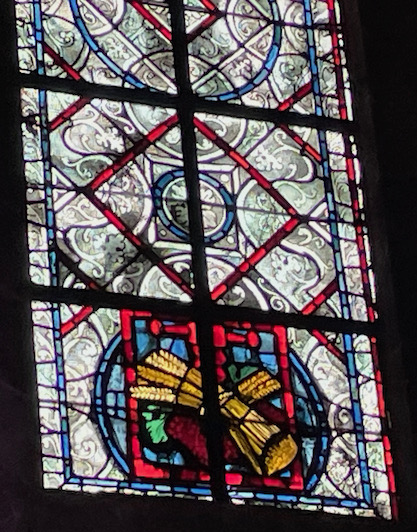
This is a very complex stained-glass window, which pre-dates the new Mixed style you just saw. These were done in the 1220's and is called the window of Saint Julian the Hospitaller and it is a "history" window, meaning that each scene tells a story in a specific history. In total, there are 34 panes in the story and they are read bottom-to-top and left-to-right. A bit of history on Saint Julian (which will make the scenes more understandable), on the night he was born, a curse was laid upon the child saying that he would kill both his parents. When he found out about this, he swore he would never do this and left his parents to stay as far away from his parents as he could.
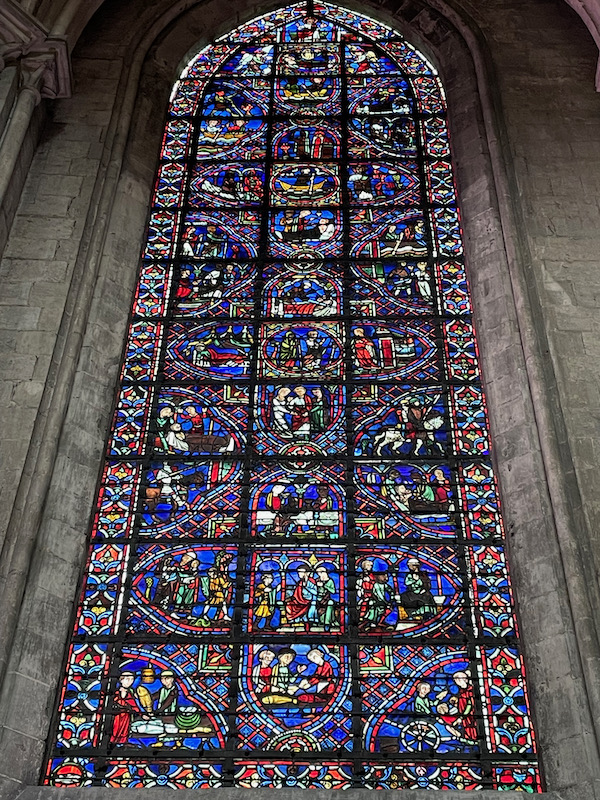
On the bottom, you can see scenes 1, 2, and 3, which are (left-to-right), which together tell the story of fishmongers plying their trade at a stall or on the street. These 3 panes were donated to the church by the local fishmongers. The next row up are scenes 4, 5, and 6 (left-to-right) which are Young Julian being charitable towards an father and mother, each of them carrying a child: then Young Julian talks to his parents: and finally, the adult Julian kneels before his father and bids him farewell.
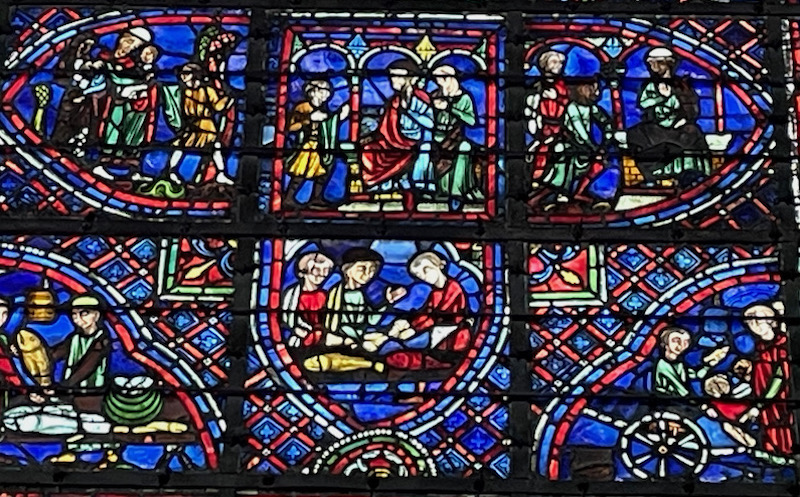
To finish the story, fast forward 20 years and his parents to go look for him, by chance meeting Julian's wife outside of a church. Realizing it was her in-laws, she invites them back to their house and they go to sleep in Julian's bed. The devil found Julian while he was hunting and told him that his wife was in bed with another man. Julian returned home and found two people asleep in his bed. Thinking that they were his wife and her lover, he killed them both (bringing to fruition the original curse). When he discovered his mistake, he vowed to spend the rest of his life doing charitable works.
The Chapel of the Virgin is the axial chapel of the cathedral (so a chapel built behind the choir) and was completed between 1305 and 1311. It is quite long for a chapel and almost looks like a small church on its own. The Baroque carved and gilded wooden altarpiece with a painting of the Adoration of the Shepherds was offered by the Brotherhood of the Holy Virgin.
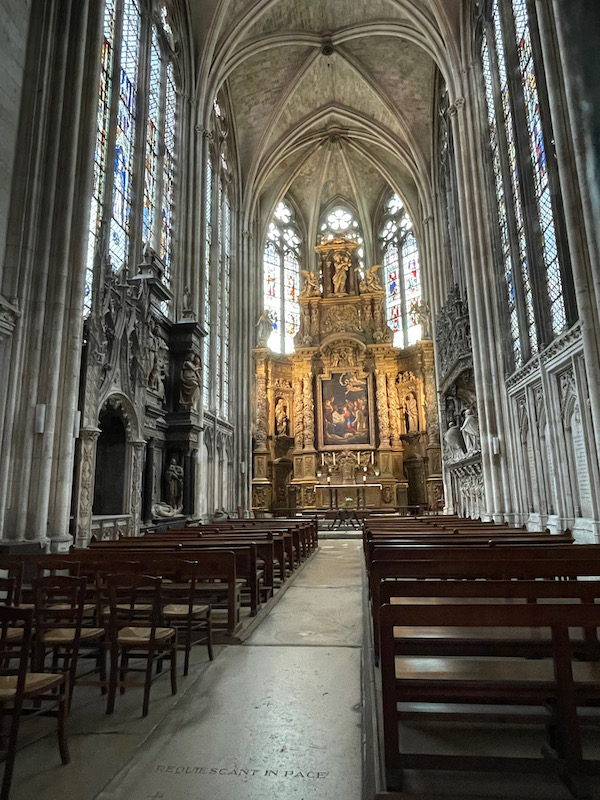
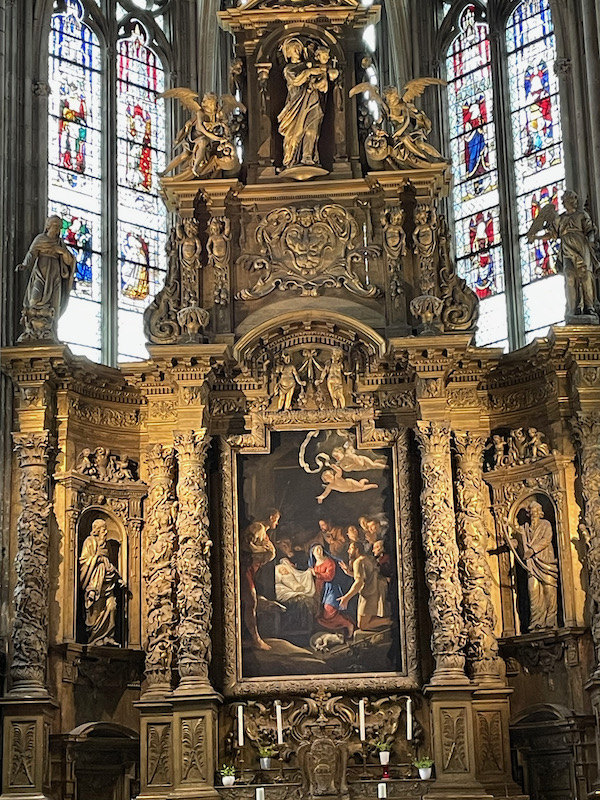
On the left-hand side is a large mausoleum for 2 Grand Stewards of Normandy, Pierre de Brézé and his grandson Louis de Brézé. The area was roped off so I couldn't get a straight-on picture, so it isn't the easiest thing to see. On the left side, with a large Flamboyant Gothic arch, is the Grave of Pierre de Brézé (1412- 1465). Moving to the right is the tomb of Louis de Brézé (1463-1453) with a transi (a sculpted monument of the skeleton or decomposing dead body) of Louis de Brézé (bottom) and then above that is Louis de Brézé on his horse, ready for combat (you can see the head of the horse). The right-hand side of the mausoleum has 2 caryatids in antique style.
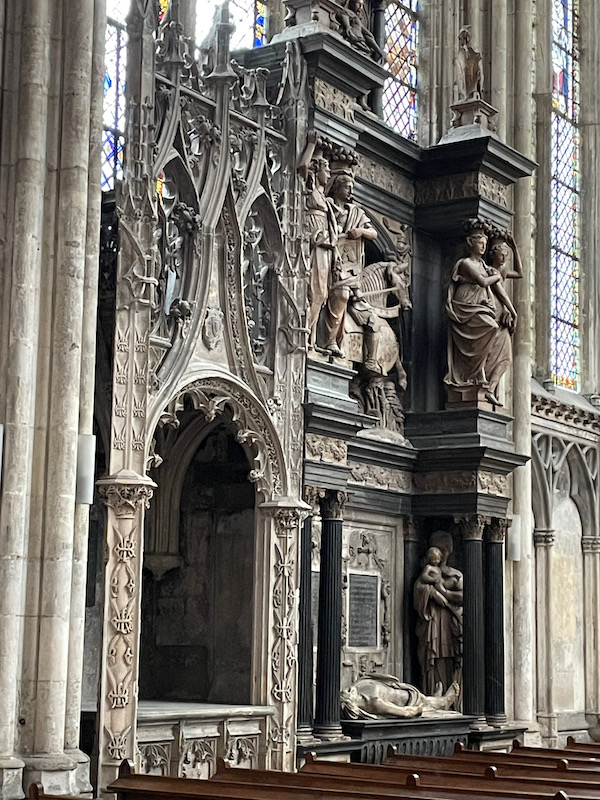
The ambulatory houses recumbent tombs, each of which has an epitaph. This one is that of Rolf le Marcheur (sometimes just called Rollon), a Viking lord that died in Rouen around 932. He participated in the first wave of expansion of his territory, which would later constitute the Duchy of Normandy and is considered the first Duke of Normandy. The recumbent figure here is actually a 19th-century copy of the recumbent figure of Henry the Younger. The epitaph on the base says "Within this temple lies Rollo, father and first Duke of Normandy, devastated and rebuilt by him. Exhausted by this work, he died in 933, aged over 80."
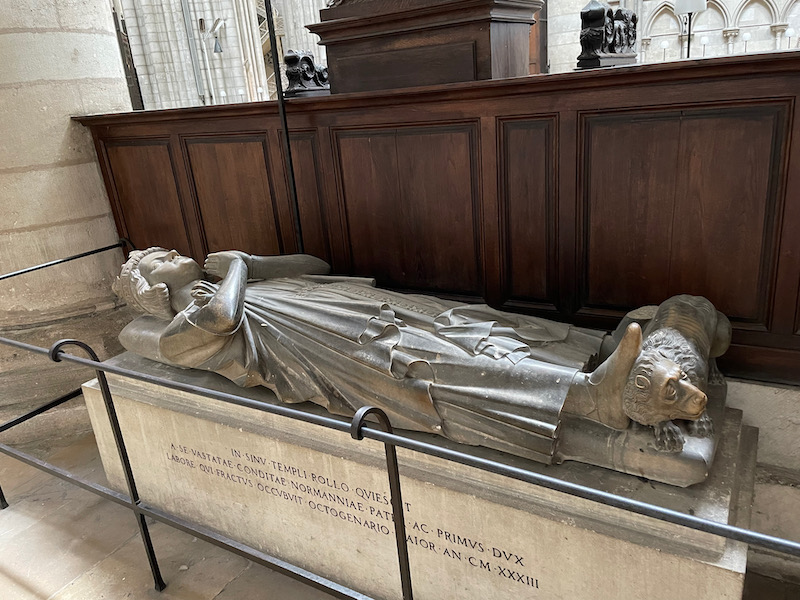
This chapel is dedicated to Joan of Arc. You can see the statue of Joan of Arc behind the altar, which contains a sword. You can see that the stained-glass windows are more modern in style. They were done after WWII and tell the story of Joan of Arc's life. The detailed window shows Joan of Arc being captured.
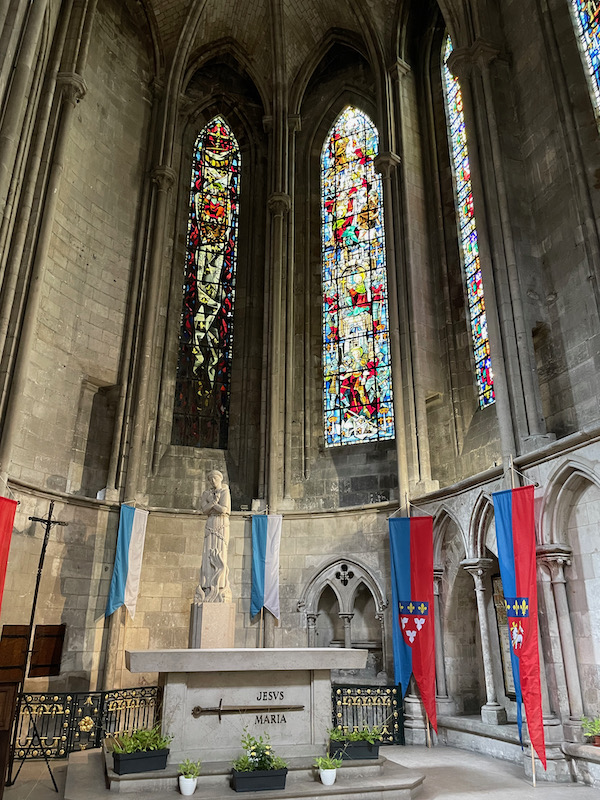
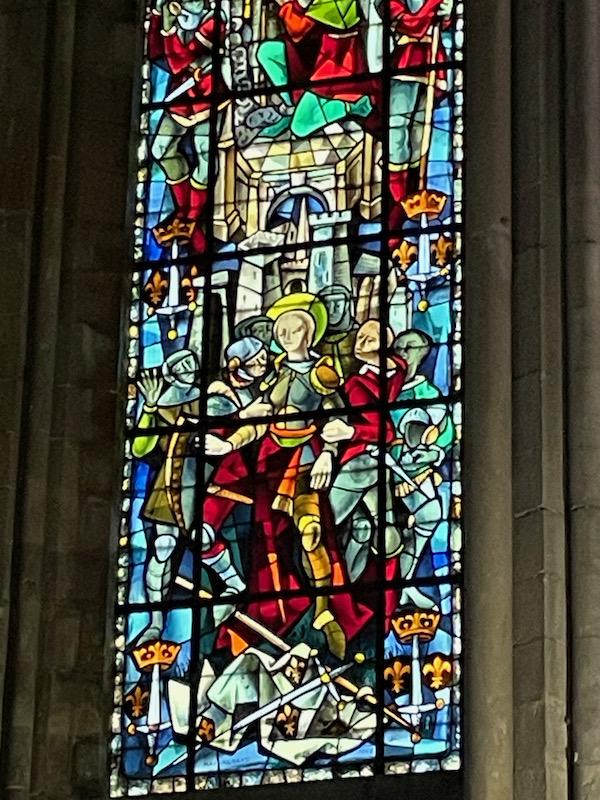
Chapel of Saint Colombe, also called the Chapel of the Eucharistic Wheat, has probably the most interesting stained-glass windows in the church. they were done by the same glass artist as many of the others done in the 20th century. The scenes represent the cultivation of wheat and the evangelical parables. Moving left-to-right, the first scene represents autumn and plowing (the plowman holds the handles of his plow pulled by a white horse), the next represents spring and sowing (the sower holds the grain in a shoulder bag with a basket and a jug at his feet), then summer and the harvest (the reaper, with his straw hat on his head, holds a sheaf of wheat in his arms and a sickle in his hand, with a sheaf at his feet), and finally, autumn and the harvests brought in (the peasant brings the sheaves into a barn). The detail shot shows scenes 2 and 3 (the middle 2).
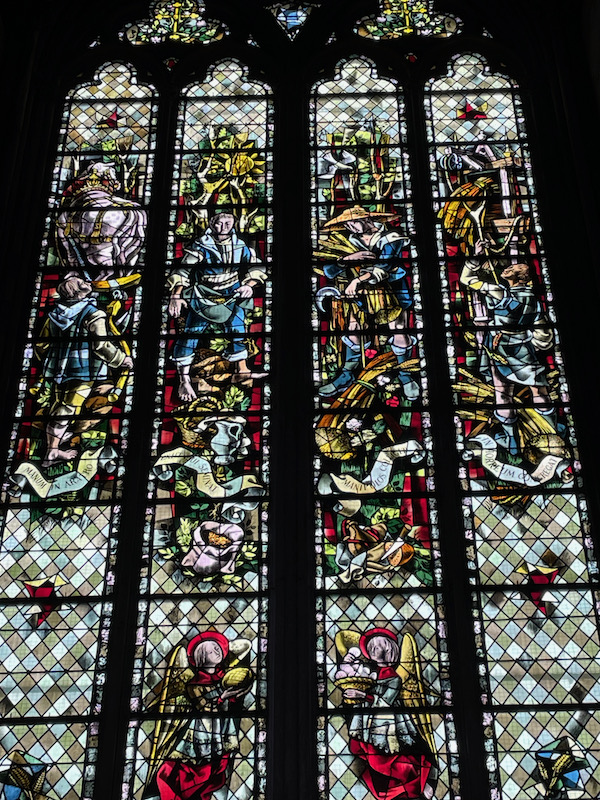
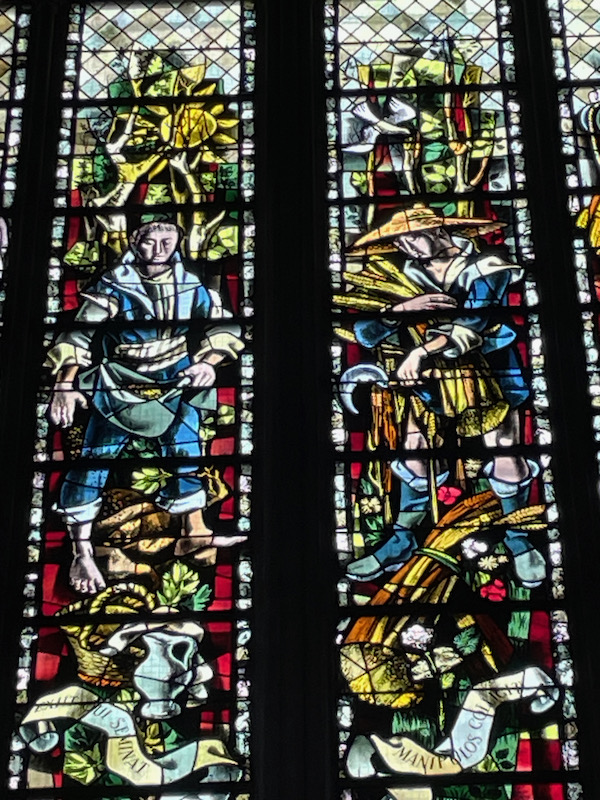
The Chapel of Saint-Agathe dates from the end of the 15th century. The stained glass windows also date from the same period although they were restored in 1960. These two panes represent the Virgin and Child and Saint Agatha.
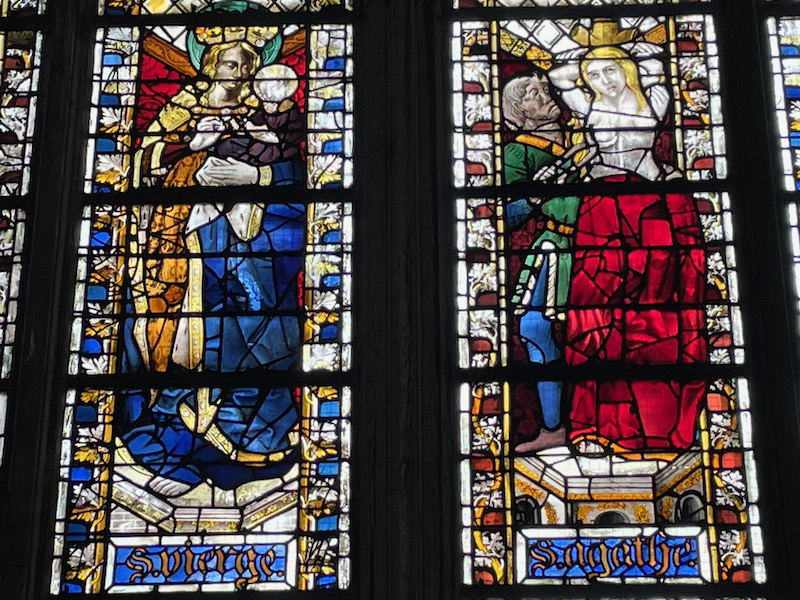
The spire of the Cathedral spire is made of metal, making it more resistant to flames. In 1822, a fire caused by lightning destroyed the previous wooden spire. To avoid this in the future, the new spire was made out of in cast iron. So you can see the bottom section which is stone (the yellow part), then the green cast iron section. Going up, you can also see a block of white ... that is a large plastic casing for some restoration work that was underway at the time. There had just been a small fire in the spire where some of the plastic caught on fire, but it was quickly extinguished.
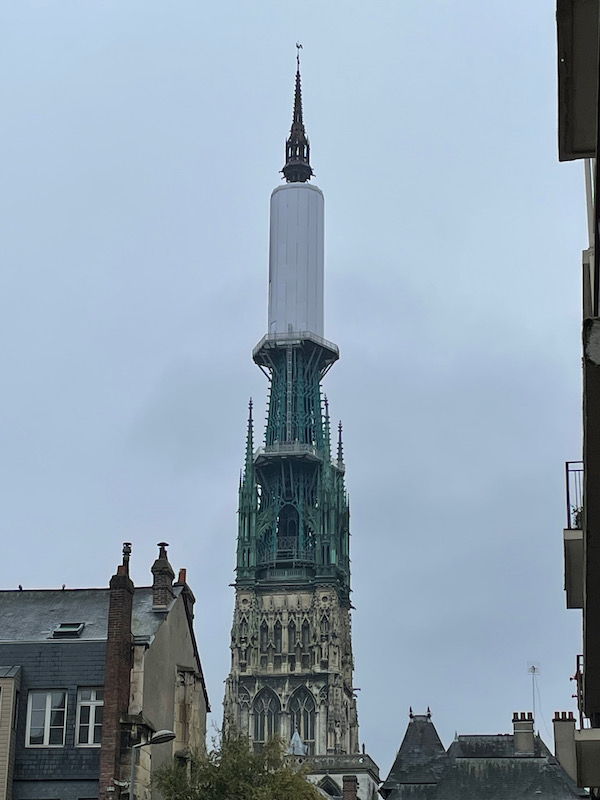
This building, which currently houses the Office of Tourism, was built in the 16th century to house the Finance Office. Throughout the years, it has had various uses, a prison in the 17th century, a performance hall during the French Revolution, various businesses until the 19th century, and now, the Rouen Vallée de Seine tourist office. A bit of trivia: it was in this building that the impressionist painter Claude Monet painted part of his famous "Cathedrals" series in the 1890s.
